#event: subversion part 1
Explore tagged Tumblr posts
Text
Transient | LMH

— Lee Minho x reader (f)
Growing up in the casino business, you—now standing at the head of your family’s imperium—know all the tricks of the trade. Rule number one: don’t gamble. It would be such an easy rule to follow if it weren’t for your company’s most trusted lawyer, Minho Lee, who loves nothing more than to raise the stakes.
AU/Trope: lawyer!au, smut (minors DNI)
Warnings: sub!minho, rope bondage, sensory deprivation (blindfolding), impact play (face slapping), wax play, knife play, one small drop of blood, choking, spitting, light cockstepping, no aftercare, power dynamics, complicated ‘relationship’ (two people using each other because they’re bad at feelings)
WC: 4.8k
A/N: This piece was originally uploaded to my old sideblog linoguistics and written for the s! week sub!skz event by @skzseasons, check them out for more. Many thanks to the wonderful @hesperantha for beta reading. ILY!
© hobivore Reposts, translations and modifications are not allowed. All events and characters are fictional and for entertainment purposes only.
— SKZ masterlist | Ask box

“Will that be all, boss?”
Boss. The word ricochets against his teeth and rolls off his tongue like a caged bird set free. Only Minho Lee could make a title sound like that: like a prayer, a taunt, a pet name, a challenge.
The tilt of his head tells you he already knows this isn’t all. Of course he knows; it’s nearing 1 a.m. on a Tuesday, and you wouldn’t have him come over to your apartment only to deliver you the most recent news on the acquisition of Full House Entertainment. Sure, it’s an important step for your company, but acting the herald is way below his pay grade.
No—Minho is here for something else entirely, and his feigned innocence is all part of this cat and mouse game the two of you have been playing for years now.
He waits for your answer, shoulders straight, something subversive to the set of his mouth. You let your gaze travel down his figure, stretching out the silence until it thickens the air with tension. Your fingers play with the silver necklace around your neck, lingering on the edge of your collarbone, and he swallows.
You suppress a chuckle at the familiar, telltale sign betraying him. In a way, you and Minho have grown into your roles in the company alongside each other. It had been your father who had hired him—although he probably wouldn’t have, had he known the man would end up in his daughter’s bed—when Minho was fresh out of law school, stiff-collared, hungry, ready to take on the world.
To Minho’s credit, he remains still, and when your eyes meet his again you see a hint of that same fervour behind them. But rather than a spark of wildfire, it’s the burning of a furnace; calculated and controlled, white-hot.
“Drink?” you inquire, more command than question, walking towards the cabinet and opening a whiskey decanter. He follows your movements, watching closely. Even when you turn around to pick up a glass you know his gaze never travels below your shoulders. His self-restraint is admirable.
“Tell me,” you hand him his drink and he takes it, clinking the edge of the glass against yours. “What do you think of Nick Blake?”
Minho narrows his eyes. “He’s a fool.”
Nick Blake is the current chief financial officer of Full House Entertainment. You’ve been told that although he may be new to the position, he shows promise, so you tilt your head in interest at Minho’s response.
“I’ve heard other things.”
Minho swirls the liquor around in his glass and shrugs. “Whoever you heard that from is wrong. You should’ve asked me.”
You raise an eyebrow at his brusque tone. Few men would have the guts to say something like that to your face—or behind your back, for that matter. But Minho has never been anything but forthright with you, quickly becoming one of your most trusted employees. And he knows it; knows he can get away with a lot more than the average member of your staff.
You decide to challenge him, to push back a little and see if he stands his ground. “Last time I checked, this was my company. I’m perfectly capable of deciding who to seek out for counsel.”
“It is. You are. But none of us benefit from mistakes. I don’t trust him.”
You sigh. Ever since you took over from your father the company has grown explosively. The profits are great, but with diverse lines of business comes an increased difficulty in oversight. You find yourself needing to rely on others more and more—something you don’t particularly like.
“So you think I should fire him?”
Minho takes a swig of his whiskey, eyes meeting yours. “I don’t know, aren’t you the boss?” he retorts, defiant, one brow raised.
You snort—an ungraceful sound—and he grins. You put your glass down on the cabinet and give him a small nod. “Thank you for your honesty. I will reconsider Blake’s position.”
A silence falls between the two of you, not unwelcome, some of the earlier tension permeating the air again as your eyes fix on the curve of his cupid’s bow. The anticipation feels familiar in a way that puts you at ease, makes you relax.
Minho is not the type for small talk and useless chatter. It's one of the things you like about him; he's astute and straight to the point. He doesn't waste your time.
And unlike most others he doesn't try to flatter you. It's a welcome change from the sycophants that come with your position. Instead, Minho has always relied on his wits and his sharp tongue. Navigated his way through the muddy water of rules and regulations until he knew them like the back of his hand. Knew how to bend them and how to break them.
There was a certain softness to him at first, back then; but much like you, he’s always been quick to adapt, quick to change.
You don’t pry into his personal life. You don’t ask and you don’t care. Just like you don’t care how he gets things done as long as he does them—because you know he always delivers, one way or another. He doesn’t keep to his luxurious office, preferring the grimy underbellies of your casinos instead, not afraid of getting his hands dirty.
Still, it’s all too easy to picture him as a deer-eyed, grubby-kneed kid, growing up watching the same programs on TV as you did. Fast-paced animations, colourful heroes saving people and serving justice. And then, later, the hours spent behind stacks of books, in courtrooms, for a good cause, only to end up here—
But Minho isn’t innocent. Every move and every choice he makes is deliberate. He, like no other, knows the world isn’t black and white. He wades through the grey fog, always mindful of the lines he should not cross.
It seems you are his only exception.
There’s an irony to it, its taste bittersweet on his tongue every time you kiss. An acidity to the both of you circling each other as you take his glass, your fingertips brushing against his skin.
“What do you want?” you ask, putting his drink down next to yours. You wait for him to say the word, confirming that he wants this as much as you do.
“I’ve missed you,” he says, and it’s out of line, teetering on the edge of mockery if it wasn’t for the honesty in his eyes. His long lashes caress his cheeks when he blinks, twice. “Venom.”
There’s a beat of silence as the word hangs in the air between you, followed by his look of surprise when the flat of your hand connects with his cheek. The expression lasts only a second, quickly overtaken by something darker as his skin flushes pink.
“I asked you a question.” You step closer, grabbing his jaw, fingers pressing hard into the soft flesh of his cheeks, distorting his grin. “Answer me.”
It’s a deflection, an attempt to steer away from his admission, and it works: the immediate effect it has on him, how it makes his pupils dilate and his breath hitch in his throat.
“Please,” he says, barely audible, mouth forced into a pout by your hold on him, “make it hurt.”
His words trickle down your skin like molasses and settle deep in your belly. You press your lips against his, tasting the rich, smoky flavour of the alcohol you’ve been raised on, coupled with that sweet taste that’s so unmistakably him—
Minho lets out a sudden moan as you sink your teeth into his bottom lip and you swallow the sound, letting go of his face, not missing the way he sways into you as you lean back and tap one finger on his suit jacket. “Follow me.”
There’s a shift in the air as you enter your bedroom, a place he’s seen countless of times—a privilege reserved to only a handful of your lovers. You can feel his presence behind you, heat radiating off him in waves, feeding your own excitement.
“Take off your clothes,” you instruct, walking towards a large wooden chest beside the bed, “and get on your knees.”
When you turn back around, a long piece of red rope in your hands, you’re surprised to see him kneeling on the thick rug already. His eyes are trained on the floor and his clothes lay next to him, neatly folded.
“Someone’s eager tonight,” you smile and grab a fistful of his dark hair, tilting his face upwards.
“Just making it easy for you,” he grins, “for now.”
You tighten your grip and he shivers at the pinpricks of pain tickling his scalp. “You’ve always liked to play with fire.”
He tilts his head, as much as your hand allows. “A man can hope.”
You crouch down in front of him, noses almost touching, catching his half-lidded stare. “Show me you deserve it.”
Rising to your feet again, you instruct: “Arms in position.” He puts them behind his back, forearms parallel to each other, fingers grazing his elbows.
You carefully wrap the rope around his forearms, then twice around his chest, right above the pectoral muscle. Putting your hand in his, you ask him to squeeze it. “Good?”
He confirms, voice low, and you bring the rope together at the back to tie it to the loop on his wrists, locking the box tie with a sturdy knot so his upper arms are confined against his body. Your fingers adjust the hemp where needed, your own body remembering the familiar motions. You wrap the leftover rope around his torso, this time just below his pectorals, across the sternum, and fasten it at the back.
You check his range of motion one more time before stepping in front of him, admiring your handiwork. His arms are pulled back, chest rising and falling steadily, pushed forward by the rope. The red hemp forms a striking contrast to his skin and when your fingers skim the side of his shoulder he shivers, the muscles in his thighs tensing.
With a pleased hum you notice his responsiveness to your touch. Your gaze drops down to where his cock hangs between his legs, already half-hard. The sight of him on his knees, wrapped up and presented to you like an offering, sends a lick of heat down your spine and you fight the urge to reach out and touch him again—there’s a time and place for your own desire, and it will have to wait for now.
You walk back to the chest and take out a bottle of massage oil and a silk sash, sifting through the chest’s contents until you find a small white box holding a collection of candles: massage candles, coloured soy flakes, and plain white paraffin candles. You know Minho prefers the latter, their heat more intense, the hot wax contrasting the colder air in the room. For a moment you consider starting with the massage candles just to rile him up, to have him writhing in his restraints and begging for more—but tonight’s not a night for such patience.
You take the necessary precautions for his safety and return with the items, displaying them on the carpet in front of him.
He watches you pour some of the oil on your hands and tilts his chin towards the candles. “Looks like it’s my lucky day today.”
“Don’t be so sure of that.” You kneel down in front of him and smooth one hand over his chest. “I haven’t started yet.”
Expertly, you massage the liquid into his skin, enjoying the warmth of his body underneath your fingers. When his chest and stomach glisten in the muted lighting you move behind him, lathering his shoulders with copious amounts of oil. Minho’s silent except for the occasional sharp inhale when you graze your nails over his skin, the subtle scent of sandalwood filling the air.
“You’re sensitive today,” you murmur as you trail your fingertips down his nape, gooseflesh erupting in their wake.
“It’s—it’s been a while,” he groans, teeth clamping down on his bottom lip when you press your front against his back, reaching around to rake your nails over his chest. “I’ve been away for a long time.”
You ignore the implications of his words—you know he could have anyone he wants, anytime, anywhere—before they can unravel the frayed edges of your chest, forcing yourself to focus on the sharp press of your nails.
“Good,” your breath ghosts the shell of his ear as he shifts under your rough touch, “more fun for me.”
You stand up and move to face him again, tutting when you notice he’s closed his legs a little, looking for some friction on his aching cock. You nudge one thigh with the toe of your shoe. “Keep them spread.”
He obliges, albeit reluctantly, and you bend down to adjust the ropes around his torso a bit, making sure to linger in front of his face. His eyelids flutter, gaze briefly flicking up to your chest, and you chuckle.
“Like what you see?”
“Always,” he says, amused, despite his impuissance. “I told you I’ve missed you.”
You smile at his words, their intent unmistakeable this time. And it’d be a lie to say you didn’t enjoy this, this back-and-forth between the two of you, even though you know he doesn’t mean half of what he says; weaponises his words and uses them to try and get a rise out of you. He’s a lawyer, after all. A good one.
And all good lawyers lie.
“Don’t make me hit you again.” You give the ropes a last tug, straightening your back.
“Now that—” Minho shakes the hair out of his eyes, looking up at you, “—that would be a real shame.”
“Absolutely,” you confirm, picking up the black sash, mirroring his smirk. “You’d like that way too much. Besides,” you tie the fabric around his head, “you haven’t earned the right to look at me just yet.”
Minho opens his mouth, witty response dying on his tongue as your oil-slick palm, unseen, wraps around his cock. “Fuck—” he curses, and you squeeze him, once, before removing your hand again. He groans. “That’s not fair.”
You bring your face next to his, lips brushing his cheekbone. “Nothing in this world is fair, Minho. You of all people ought to know that.”
Crossing the room, you grab the dressing table chair and put it down in front of him. His shoulders tense at the sudden sound; it’s the only reaction he shows, putting on a false display of nonchalance as you sit down and light a candle.
At first glance he does appear at ease, but you notice the small signs of tension: the quickening rise and fall of his chest, the tautness in his shoulders, the tremble that runs down his body at the soft click of the lighter. His head is slightly cocked, turned towards you, trying to catch any sounds you might make when you dribble some wax on your own arm to test the heat.
When the first drop hits his skin he hisses sharply, wax trickling down his chest. You know it doesn’t hurt when drizzled from this height, not really, a mild sting at most—but being blindfolded and unable to anticipate your next move is enough to have him on edge.
You pour the hot wax on his shoulders, his chest, his arms. The room is quiet as you work in silence, adjusting the heat and intensity by moving the candle closer or farther away from his skin. He bites back a whimper as some of it drips on a nipple, trying to stay focused, trying to predict your next move.
But when you press the sole of your shoe against his neglected cock he whines—loudly—and you laugh. You keep it there, the pressure not enough to satisfy him, and he shifts uneasily under your touch.
“What do you want?” You feign innocence, voice flat and uninterested.
“Please—” he begs, hoarse, “—more.”
“Go on then. Move.” You dribble the hot wax on his upper thigh, close to your foot. He groans in response and rocks his hips, reluctant at first, almost shy, giving in with a choked-off sound. He’s more frantic now: previous restraint gone, the rope spanning taut across his chest, his knees digging into the carpet.
Minho tends to be quiet, holds back his moans as if he’s afraid they’d escape the room. But you know his cursing is only a preamble so you aim to draw out every sound. To coax them from his lips until he can’t keep them caged behind his teeth any longer.
“Look at you,” you muse, in awe of the vision of him, “such a desperate mess.”
It’s a sight few people get to see: Minho Lee bound and covered in wax, quickly cooling, hardening into white strands of pearls on his skin. Your foot is pressing his cock against his lower abdomen, precum wetting the red sole, his thighs trembling with exertion as he ruts against it.
You squeeze your own thighs together in an attempt to find some relief and when his tongue darts out to wet his lips you can’t help but lean in, blowing out the candle and crashing your mouth against his, taking him by surprise. The kiss is messy, feverish; all tongue and teeth as you nip at his lips, a hand tangling in his hair.
He objects, a faint whine, when you pull back and take your foot off his cock. “You did so well,” your voice sounds breathy as you untie the sash, steadying your wobbly, eager fingers, “you deserve a reward.”
Minho blinks, letting his eyes adjust to the light, pupils still blown wide and unfocussed.
“But you’ll have to get it yourself.”
You hike your dress up, spreading your legs, inviting, and he sucks in a sharp breath at the sight of your soaked panties.
“What are you waiting for?” you bait, enjoying the brief, rare glimpse of bewilderment flickering across his face before he collects his bearings and shuffles closer on his knees, until he is mere inches away from your clothed core.
Minho closes his eyes, the muscles in his neck and shoulders tensing as he leans forward. His skin is still covered in dried wax, which has started to flake, but he doesn’t seem to care—too preoccupied with pushing his face into the black lace at the apex of your thighs.
When he flattens his tongue against the fabric it’s you who has to suppress a moan, nerves set alight with every nudge of his nose.
“Ugh—this—” as expected, it doesn’t take long for him to get frustrated with the barrier keeping him from tasting you properly, “—is supposed to be a reward?”
You grab his hair, tugging at it sharply, noticing the way he hisses in response. “Don’t get greedy now, Minho.” Your index traces the edge of his jaw before giving him a gentle smack on the cheek. It’s nowhere near firm enough to be satisfying, only serving to fuel his impatience. “I can leave you here and go back to my other employees, if that’s what you prefer. Or we can continue like this.”
He narrows his eyes. It’s nothing to him if it isn’t a competition, a dispute, always and everywhere—in the courthouse, at the office, in your bed. You know he would’ve lost interest long ago if you hadn’t met him with the same fervour.
His jaw ticks, determined, and he sits up, taking the hem of your panties between his teeth. You lift your hips so he can pull them down your legs, clumsily yet insistent, until they gather around your ankles. You lift one foot out of the fabric but before you can move the other leg Minho is already back, his face between your thighs.
When his mouth connects with your core he exhales, mumbling, “Fucking finally,” cutting off your reply with the plush of his lips wrapped around your clit. You can feel them curl against your skin at your jumbled words, warning him, a hand tangled into his hair as you hold him impossibly closer.
It’s a little embarrassing how fast the knot in your stomach tightens, only to be unravelled again by the expert teasing of his tongue. “Fuck—Minho—” you gasp, and he pulls back slightly, slowing down his motions until you can feel your high ebb away, just out of reach.
You groan. “Stop teasing.”
He chuckles, the sound reverberating through your body, and you shiver. “Am I not good enough?” He leans back and looks up at you, eyes glinting. “Maybe you should go back to your other employees instead, then.”
His smile is a little crooked, and he tongues the inside of his cheek, as if he’s waiting for you to make a move. Expecting you to lash out or press your heel against his cock, anything—
You won’t give him the satisfaction.
“Don’t threaten me with a good time,” you bend down until your face is in front of his. “Miller is more than capable.”
His expression falters for a second, morphing into something unreadable before he puts his carefully crafted mask back into place. “M—”
You cut him off with the press of your fingers against his lips. “Open.”
He obliges, eyes falling shut as you grab his tongue between your thumb and index and spit on it, coating your fingers in the mixture of saliva and arousal and spreading it over his already saturated face.
“Go on, Minho Lee,” you tap his bottom lip, ignoring his protest as your fingers leave his mouth, “show me that tongue is good for anything other than fucking the law over.”
This time he doesn’t have to be told twice, working a steady rhythm, paying close attention to the sound of your moans and the involuntary shaking of your legs.
He revels in it: on his knees, restrained, driving you to the edge and turning you into a whimpering mess. It’s a small price to pay for the pleasure that crests over you in waves, the soft strokes of his tongue bringing you down from your high.
Through the distorted blur, stars behind your eyelids, you see his face, still covered in a mixture of arousal and spit. A pleased smile pulls at the corners of his lips and you suddenly feel exposed despite his state of undress.
Rising to your feet, you pull your dress down and flatten the fabric with your hands, eyeing the way he tries to adjust his arms within his confines. “Let me clean you up and get these ropes off.”
You retrieve a stainless steel knife from the chest, kneeling down in front of him and carefully chipping away at the dried wax on his shoulders. It peels right off, the scent of sandalwood filling your nose once more now you’re in such close proximity to him. It’s mixed with something sharper, something you’ve come to associate with him—intimately familiar, a scent you could pick out in any room.
The blade drags across his collarbone and he shifts on his knees. “Don’t move,” you warn, enthralled by the gooseflesh erupting in the wake of the cold metal. A few inches higher, there’s the steady beat of his pulse, pressing against the steel.
“I could kill you.”
The laugh he lets out is soft but complacent, a low rumble deep in his chest. “You won’t. I’m too good at my job.”
There’s a sharp pang behind your breastbone. Does this count as work for him, too? When you call him late at night, is there ever a part of him that doesn’t want you?
“Men can be replaced.”
He turns his face towards you, the curl of his lips turning treacherous. “You like me too much.”
It’s cocky, smug, and you hate it—hate how it’s the truth. In moments like these you wonder if he knows how much power he holds over you, and not for the first time tonight you’re thankful for the pokerface you were taught to wear.
You press the tip of the knife into the hollow above his clavicle, a red drop blooming underneath the steel. “For a man so meticulous you’re pretty reckless sometimes.”
If he felt the small cut he doesn’t show it, tilting his head towards the floor instead, angling it away from the sharp metal. “If it isn’t for me, it’s for this ridiculous pristine rug. I know it was a gift from your father. I’ll live.”
It’s there, as always, woven between the threads of light-hearted banter and off-handed sarcastic remarks; something that shouldn’t exist between the two of you, something that has no place in your world: trust. Even if it exists only in these rare moments—fleeting, transient, a gossamer thread.
You shake your head and straighten your back, stepping behind him, worried he’d be able to hear your heart hammering against your ribs. Sometimes it feels as if he can see right through you—it makes you nervous, kept on tenterhooks, your intricate house of cards threatening to collapse.
Busying yourself with prying the last bits of wax off his skin instead, your other hand traverses over his chest and shoulders, feeling the ridges and dips of sinewy muscle underneath. He leans into your touch and heat courses through your body as your own desire flares up again. You untie him and help him to his feet, his fingertips leaving scorching marks on your skin as you realise it’s the first time they’ve touched you tonight, a promise for more.
You swallow thickly. “Get on the bed.” There’s an urgency to your voice that wasn’t there before, and you’re thankful he holds his snarky retort and clambers onto the bed without a word, back against the soft mattress.
When you finally sink down on his cock it takes you all your effort not to moan loudly, hissing through clenched teeth. He’s right—it has been long, too long, and the slight burn as he bottoms out only fuels your arousal.
The tips of his fingers caress your knees, but you allow him, too preoccupied with rolling your hips just right so his cock brushes against that sensitive spot every time you push yourself back on his thighs.
His half-lidded gaze travels over your body and you put your hands on his shoulders, steadying yourself as you set an unrelenting pace. His jaw slackens at a particular motion of your hips so you repeat it, bending down to capture his mouth with your own, the faint taste of your own arousal still lingering on his tongue.
“Ah—please,” his brow furrows as if he’s in pain, pleasure overwhelming his senses. “Please let me fuck you.” His hands hover above your thighs, waiting, desperation lacing his voice at the thought of your refusal.
Your fingers graze the edge of his jaw, almost tender—wandering down to his throat, wrapping around it, as you squeeze and tell him, “Then fuck me.”
Minho plants his feet on the bed and grabs ahold of your waist, nearly toppling you over if it wasn’t for the hand around his neck holding you up. You let yourself collapse against his shoulder, his pulse quickening underneath your fingertips as his thrusts become frantic, chasing the high you’ve been withholding from him all night.
He mutters your name into your skin, a Judas kiss, and you feel your body react, disloyal—clenching around his cock, limbs leaden and heavy. Your fingers slip into his mouth, mind buzzing, a half-hearted attempt to stop his perjury.
It’s sanctimonious, though, when you fall apart around him with his name on your lips. He follows suit when you tell him to, hips stuttering before stilling underneath you. There’s a drawn-out silence, only filled by your laboured breaths. Your dress is a welcome barrier between your bodies as his hands fall away from your waist, reluctant, and you resist the urge to hold him, moving off the bed.
You watch him go through the motions you know by heart: bending down to retrieve his pants from the pile of clothes on the floor first, faint imprints of rope still lingering on his skin.
“Stay,” you say, and this time you hope it doesn’t sound like an order, “finish your drink first. You have a long trip back to Oklahoma ahead of you.”
He turns around, wearing that smile he’s mastered for your clients in court, and you already know the answer before it has left his mouth. The familiar words erode all the nights spent together until they slip through your fingers like sand.
“Whatever you want, boss.”

Thank you for reading! If you liked this story please reblog, leave a comment, tell a friend, send me a pigeon, launch a mars rover. Your encouragement fuels my inner writer cryptid 👾
#stray kids smut#stray kids hard hours#lee know smut#lee know hard hours#lee minho smut#lee know x reader#sub!skz#sub!idol#sub!kpop#skz smut#skz hard hours#stray kids imagines#skz fanfic#stray kids fanfic
192 notes
·
View notes
Text
GENRE TELEVISION, in fact, follows a literary tradition of illuminating the main plot’s action through comedy. Who can forget Shakespeare’s Fool mirroring Cordelia in King Lear; Falstaff’s antics caricaturing the character conflicts in Henry IV, Part 1; Rosencrantz and Guildenstern’s misadventures anticipating the greater tragedy in Hamlet? As these examples illustrate, comic subplots and dialogue serve a twofold dramatic purpose: permitting subversive themes or transgressions of cultural taboo (i.e. “speaking the unspeakable”) under the guise of absurdity, and thereby foreshadowing or contextualizing major plot events to come. In this essay I will examine how Supernatural season 3 episode 13 “Ghostfacers,” in blithely revealing the series’ central thesis via the line “gay love can pierce through the veil of death and save the day,”
#draw your own conclusions! or: THIS is what you do with a BA in English#this is also to say that essay project I've teased isn't dead! I'm just a bad procrastinator. new year's resolution to finish it#so pls accept this teaser for its thesis as a gesture of solidarity#supernatural#spn#dean winchester#castiel#destiel#spn meta#spn crack#spn is queer#mine
153 notes
·
View notes
Note
Do you have a method or strategy for outlining the entirety of CHNT/any story?
I’m bangin at writing scripts but big picture? Oof ouch me brain.
I can offer you a quick crash course on story structure.
If you're writing a story with a purpose and an ending, reference the three act structure:

Particularly, a beat sheet, which breaks down the components of the three act structure into notable, key happenings, which all work together to drive the epicenter of your narrative.
There's no single interpretation of something as fundamental as the three act structure, but the Hollywood standard for storytelling references the following sheet:
ACT ONE
1. INCITING INCIDENT - This incident starts the whole journey. It's the spark that lights the fire. In other words, it must be a critical occurrence. If this thing does not happen, the rest of the story doesn't happen.
2. HOOK - The beat which "hooks" the audience and makes them want to see more. Often it is a preview of the theme, the character's flaw, or the coming Plot Point One.
3. PLOT POINT ONE - The event which defines the main challenge the protagonist must deal with through the second act and leading to the climax. Whatever you set up in Plot Point One must be paid off in the Climax.
ACT TWO
4. CONFRONTATIONS/RISING CONFLICT/COMPLICATIONS - As we come to understand the characters, we also learn more about the challenges and raise more questions. The protagonist struggles against initial conflicts/challenges, which should be consistently escalating.
5. MIDPOINT - The stakes are raised in an unexpected way, leading to a whole new set of conflicts and deeper challenges for the protagonist. Sometimes it will be the moment in which the protagonist is challenged to fully commit to fighting back/pursuing their goal. (I like to think of this point as "the point of no return" in which everything the audience knows about the story is changed in some way.)
6. RISING CONFLICT TO PLOT POINT TWO - Conflict continues to rise, leading to Plot Point Two - sometimes referred to as the "all is lost" moment. Enemies are winning, tragedies happen, values are tested. The situation seems hopeless. This is the lowest moment for your protagonist.
ACT THREE
7. CLIMAX - The protagonist's final face-off with the conflict. The challenge and stakes that were set up in Plot Point One are confronted for the last time.
8. PAYOFF - The direct result of the Climax. The protagonist succeeds or fails. Sometimes it's more complicated.
9. RESOLUTION - How our characters are left at the end of the story, and a suggestion of what the future holds for them..or not if they're dead. In certain stories, the resolution may leave the audience with a parting question.
You also need to study the structure of a character arc, as it will inform your beats. A dynamic character meant to change will have the following characteristics:
GOAL - Motivation. What they want, whether it be something they're working towards, or something they already have and need to hold onto. A goal must always be actionable. FLAW - This is the thing holding your character back, and is either directly causing, relating, or contributing to the conflict. NEED - What your character requires to grow and change. Think of the “need” as the “solution” to the flaw. In most cases, the result here is often a theme in the story.
There's an abundance of reading you can do on this theory and over a million different interpretations, so it can be overwhelming what to listen to.
❗ I recommend Save the Cat as a starting point.
No matter how you approach it, you cannot skip out on beat structure. It's the thing that tethers your story to itself instead of getting lost in concepts, that centers your theme and engrosses the audience. Ignoring it or trying to subvert it for the sake of subversion will kneecap your story and have the audience going :

#askbox#gosh I hope it is not irritating I am always writing these longform responses#clock of meantime was a meta referential to this#the 'meantime' between story beats
80 notes
·
View notes
Note
also re: the racial component of TS/fan base, if you haven't you should watch Alex Avila's video on Taylor Swift, I think it was really well done
youtube
this is SO good. thank you SO much for this recommendation.
i really liked how avila noted how masterfully taylor blends authenticity and social normativity - "the reason taylor swift seems so authentic to young girls is because she's conforming to an image [of white patriarchal girlhood] that young women internalized from a young age." similarly, the popular feminism of 2014 (when 1989 was released) was flimsy and did not challenge patriarchal norms, and we see how she made feminism part of 1989's branding.
and he asks a question i often pose: is there anything subversive in idolizing the most popular cultural object? does poptimism (the critique of pop music as a serious form of art) simply reinforce existing power structures??
taylor swift and whiteness
understanding how someone becomes a legend and icon means understanding how they challenge, but also reinforce, the biases in society, which includes race, class, gender, and so forth. and "there IS something deeply white about [taylor's] image" (1:18:33). her image is cultural whiteness! taylor swift's relatability (which is and has always been part of her brand), her social capital, her social normativity, is directly tied to the neoliberal racial philosophy that, instead of calling whiteness superior, establishes whiteness as the norm (1:21:23).
millennials want celebrities to be morally pure. this is a mistake.
also - LOVE that he points out that millennials don't judge female celebrities by their sexuality or modesty anymore, but instead they judge based on political awareness, which is just another way of continuing the "patriarchal history of regulating narratives around women's actions" (1:42:39). avila focuses specifically on millennials here, cautioning us not to consider this a a sign of true political engagement from millennials. as he points out, systems of oppression adapt to our ever-changing culture. when we try to 'cancel' or 'hold a celebrity accountable' for their ideologies or missteps, sometimes it's because they're truly terrible, and other times it's because we hold women to "unrealistic standards of purity." ie, this isn't necessarily real political engagement, it is just another example of judging women. often it's both (pointing out missteps, and also being sexist.)
whiteness again
avila goes on to discuss how white women have long been held up as virtuous, moral centers of american families - and while this is a racist and sexist practice, given that woc aren't seen as virtuous, it also lays the foundation for why white women in particular dominate conversations about politics in the public sphere. it is an Event every time a white celebrity frames their political awakening as a personal, spiritual journey of self-realization. yes, this act is important, because women must learn about their own oppression, and talk about it, in order to educate others.
but when taylor (or any other famous white woman) frames politics solely through the personal, it relieves her of the obligation to critique systemic issues. her own political awakening is all that matters - she must prove her own political purity (instead of sexual purity, as before.) there is a deep problem in society demanding this, rather than larger systemic change, but we'll get to that later.
this personal political purity awakening earns her a lot of goodwill, but her resistance ends with herself. and this is a pattern that we see happen all the time, in what robin james calls "neoliberal resistance discourses" in pop: someone is damaged by oppression (sexism), she overcomes it brilliantly with an awakening (miss americana/lover/denouncing trump era), and she absorbs this goodwill into her brand. these individual damages and awakenings supposedly symbolize society's own awakening and resilience(!). (1:52:48)
🚨 some readers might be getting tired/annoyed at this; i can hear y'all saying "well, what do you even WANT from her omg!!!" just stay with me here. 🚨
she holds a mirror up to society, tho
what avila so brilliantly points out is that... this cycle of damages and resilience isn't helpful. it goes nowhere! and we are all at the mercy of the same patterns as taylor. it's not about taylor, it's about us, and how capitalism commodifies everything, including social movements! including personal 'goodness'! a neoliberal system wants individuals to care about their individual choices and looking like good individuals; it encourages the use of "purity tests" and "commodified algorithmic social movements" to discourage challenges to systemic issues (reminds me of the celebrity blackout situation earlier this year, and conversations we have about politics, well, daily on here.) and the pattern of a person failing politically as an individual is part of this machine. if we're too busy policing individuals for their purity, we won't ever organize together for shared material goals. unfortunately, unlike taylor swift, most of us are not extremely powerful, wealthy, and influential as individuals. she does have more power than us in this regard.
taylor as cultural hegemony
anyway, avila goes on to talk about how taylor had this musical renaissance with folklore, and became more honest about her masterminding her own career in midnights. she has shown herself not just to be a musical chameleon, but a cultural one as well, positioning herself as white teenage purity when the culture called for it (circa 2008-2010), neoliberal pop feminism (1989 -> lover), pandemic escapism (folkmore) - and the culture has become part of her brand, part of her music. music that is already heavily wrapped up in her own life. she is the brand she is the culture. of course she put the work in, and not just anyone could do this. but imo, her whiteness (which, again, gives her this "default" "neutral" background to work with) is part of this success. "sure, she's challenged the institution but all in the effort to become the new face of musical hegemony" (2:06:25.) she challenges systems to assimilate into them, or create them in a way that requires assimilation.
of course, this is all based on her REAL experiences, her REAL life. she is living her own life, and also living it in this metacognitive way that mirrors culture.
but we don't have to hate taylor, actually!
and MOST interestingly, avila closes out by suggesting: it's not actually super healthy to always be suspicious and critical of art (2:17:24.) yes, there is a long political history of "paranoid reading," of critique based on marx, freud, and nietzsche's philosophies. it is the basis of A LOT of our frameworks for thinking about the world, including art.
as i've said before, it's interesting to discuss taylor or celebrities because they hold a mirror up to society. but we can't just relentlessly critique ourselves - after all, the critique is supposed to protect us from being bad! the critique is what keeps us good! and it's why we project so much onto them (the celebrities, or "bad" people.)
this video dove into a term that may be new to a lot of people (i only learned of it recently) - "reparative reading." rather than relentlessly critique art or what-have-you, engage with it in ways that is "affirmative, creative, and caring." this does not mean you toss out critical readings - reparative readings can coexist, and give us hope, optimism, feelings of beauty/appreciation, and affirmation.
for example, it's why -while i enjoy critiquing taylor (or what she Represents) - i am also here to just... have fun. i don't want to linger 24/7 on her emissions, or what she hasn't done, or who she's friends with. it's also why, as a fan of color, i hate that she is often dismissed and minimized to "white musician making music for white women." i find affirmation in a lot of her music, regardless of her race; i find optimism and hope in the way women so deeply relate to her, and how queer fans (also like myself) relate to her! (which avila points out too 2:21:00.) it's why i stopped debunking stuff, because queerness - like any other aspect of the fandom - is such a critical, significant part of why her music is beloved. it's so important for people to recognize that she is more than just 'music for straight white heterosexual cisgender women.'
152 notes
·
View notes
Text
Why Tifa is the Underdog of FFVII

I’ve been thinking about this ever since I first played Rebirth & got to Cosmo Canyon. Many folks were perplexed at the direction of Cosmo Canyon and found aspects of it surprising or confusing. I would say that it was entirely subversive for a number of reasons, but primarily, I want to focus on Tifa, because it got me thinking about her role in a much larger sense.
When I first played FFVII as a 14 -year-old girl in the late 90s, my first impression of Tifa was that she was an underdog as a character and as a heroine, especially in comparison to Aerith, the other heroine of FFVII. This was primarily due to how she was presented throughout the first disc, but also how she evolved as a character throughout the story, leading up to and through the Lifestream Scene. At the time, underdog stories particularly resonated with me (they were also quite prominent in the 90s) and they are relatable to real people. It’s one of the many reasons I fell in love with Tifa.
That being said, FF7R has really developed all of the characters in ways that gives their arcs more depth and resonance, and I think this is particularly visible with Tifa. It's especially apparent in Rebirth, especially given what we see in Cosmo Canyon and how it relates to Tifa’s previous character development, while foreshadowingi what is to come for her and her role.
In storytelling, an underdog arc involves a character who starts from a position of disadvantage, either through external circumstances or internal struggles, only to rise and succeed against the odds. The underdog heroine, in particular, undergoes a journey of emotional growth, perseverance, and resilience, transforming her into a capable and powerful figure by the story’s end. This arc creates relatability and builds tension, making the heroine’s eventual triumph all the more rewarding for both the character and the audience. Underdog stories tend to feature heavily in sports and martial arts films (hmmm) but it is a universal archetype in storytelling.
For Tifa, her role as an underdog is critical to understanding her role and ultimate evolution as a heroine, both in the OG and even more so in FF7R, which builds upon this arc more steadily and organically. Through pivotal events in the game as well as her evolving relationship with Cloud, Tifa’s underdog arc is designed to prepare her for her significant heroine arc in Part 3, which will cover disc 2 of the OG.

Let's start with the OG, where Tifa is an often understated character, particularly in the early portions of the story. In Disc 1, she plays a quieter role compared to more outwardly central characters like Cloud and Aerith. While Aerith has her connection to the Planet and Cloud is thrust into the role of the group’s leader, Tifa’s journey seems more personal and internal. Tifa's primary focus is her relationship with Cloud, who is dealing with an identity crisis that leaves him emotionally distant, confused, and susceptible to strange behaviors. Although Tifa harbors deep feelings for Cloud, her confusion over their mismatched past memories leaves her vulnerable, confused, and reticent, compared to other characters who feature more centrally.
However, this positioning as an underdog is precisely what sets Tifa up for her eventual role as a heroine. In the OG, she begins as someone overshadowed by more powerful or prominent figures, but proves to be emotionally essential, particularly in the Lifestream scene. It is Tifa, with her quiet strength and deep connection to Cloud, who helps him recover his true self from the fragmentation caused by Sephiroth’s manipulations.
Though Tifa may not have a magical connection to the Planet or the external conflict, her strength lies in her emotional resilience and her ability to anchor Cloud when he is at his lowest. This transition from being in the background to being pivotal in Cloud’s recovery is a hallmark of the underdog arc. Tifa’s most critical strength is not in her outward power but in her deep emotional ties and unwavering support. It is also a huge signal of the game’s propensity to use red herrings and subversion as a vehicle for storytelling.
FF7R takes Tifa’s underdog arc that was present in the OG and expands it more steadily and organically. In Remake and Rebirth, Tifa’s journey is given more focus and depth, allowing her character to grow gradually, especially in relation to her bond with Cloud and her own emotional challenges, such as her internal conflict over her involvement with AVALANCHE.
In Remake, Tifa and Cloud reacquaint themselves after years apart, and their relationship becomes a central focus with far more development, nuance, tension, and prominence than the OG. Early in the story, Tifa is hesitant, unsure of her place in Cloud’s life and the larger conflict surrounding them. Much like in the OG, she begins in a vulnerable position, confused about the discrepancies of their pasts, and struggling with feelings of guilt and self-doubt.
Remake carefully builds up their relationship, showing moments where they grow closer, develop trust, and begin to support each other emotionally in ways they never did before. This slow burn of intimacy is a critical part of Tifa’s underdog arc—while she may not be the most obvious heroine within the scope of the external conflict, her emotional journey is laying the groundwork for her later importance in the internal conflict.

This is reinforced in Rebirth, where Tifa’s relationship with Cloud is tested by the growing threat of Sephiroth and related external forces. From the very first chapter, beginning with their conflict in Kalm, we see the tension, unresolved issues, and external manipulation (Sephiroth) between them that will carry through the story.
This slow burn of reconciliation and tension defines their relationship, as Tifa grapples with her growing trust in Cloud while dealing with his unpredictable behavior. The climax of this arc comes in Gongaga when, under Sephiroth’s control, Cloud attacks Tifa. This moment marks a critical low point in their relationship, meant to test Tifa’s faith in Cloud and her ability to stand by him despite his actions.
However, the following Lifestream scene acts as a turning point for Tifa’s underdog heroine arc. In this scene, Tifa is essentially given a "tutorial" of sorts, which accomplishes three vital things:
1) Prepares her for her coming role in Part 3 (aka Disc 2) by reinforcing her emotional resilience and resolve;
2) Reveals that Tifa, too, has been gifted with an important connection to the Planet for a specific purpose—becoming Cloud’s heroine, the one person who can help him reclaim his true self; and,
3) Fortifies her faith in Cloud, reaffirming her belief in him despite the trauma of his attack. All of these elements are crucial in building Tifa up for her ultimate role in Part 3, where her emotional strength and deep bond with Cloud will prove indispensable.
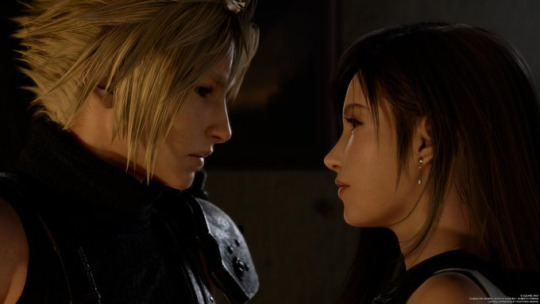
Following these climactic events in Gongaga, Tifa’s role as an underdog becomes even more pronounced during the events in Cosmo Canyon, revealing her heroine arc with greater clarity through a clever subversion of expectations. Traditionally, Cosmo Canyon is a section of the game that focuses on external conflicts, especially tied to Aerith’s role as a Cetra and her connection to the Planet.
However, in Rebirth, Tifa is also unexpectedly thrust into the spotlight in a setting that purposefully marginalizes her, with the narrative now drawing attention to her internal struggles. This shift in focus gives weight to her emotional and personal conflicts, contrasting with the larger planetary issues central to the external conflict, although centered in the same setting where those issues are the focal point.
Bugenhagen and the elders, who represent the epitome of knowledge about the Planet and the Lifestream, ridicule Tifa’s personal experiences, dismissing them as heretical and uneducated compared to their teachings. This organized structure of Cosmo Canyon, revered for its wisdom, alienates Tifa, making her feel further out of place. She is sidelined in a place where the spiritual wisdom of the Planet should matter most, yet her direct experiences within the Lifestream are discredited.
This subversion is essential to Tifa's arc: although she is overlooked by those considered authorities, it highlights her position as an underdog whose true power lies in her emotional resilience and connection to Cloud, not in abstract spiritual knowledge. Her ability to persevere beyond what she encounters in this scene is what will make her triumph in Part 3 further rewarding. The fact that the planet itself has facilitated this experience to some degree (in Gongaga) makes this arc even more compelling.
All of these events in Rebirth subtly prepare Tifa for her role as a heroine in Part 3. Despite being undervalued by those who should understand the power of her connection to the Lifestream, Tifa is destined for a crucial purpose. The Planet has clearly chosen her to be the one to save Cloud, "the boy who is destined to save the world."
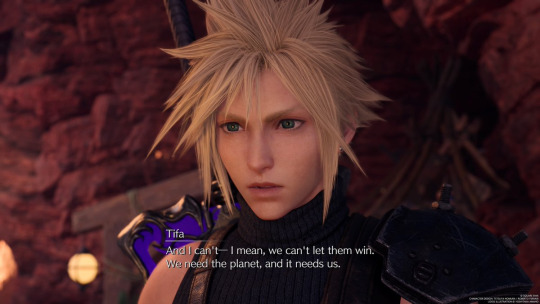

This culminates with a powerful emotional contrast that sets up her lowest point just before the game ends, perfectly priming her for her ultimate heroine role in Part 3. After the events in Cosmo Canyon and Gongaga, the narrative takes a softer turn during Tifa's date with Cloud at the Gold Saucer. This scene is crucial for both Tifa and the player, as Cloud finally gives a clear indication of his feelings for her by kissing her, offering a moment of happiness and intimacy. For Tifa, this moment of connection and affection from Cloud is deeply validating—after their long, slow burn of building trust and emotional closeness, this kiss solidifies that Cloud returns her feelings. It creates the "calm before the storm," giving them both a brief moment of peace and joy before the dark trials ahead.
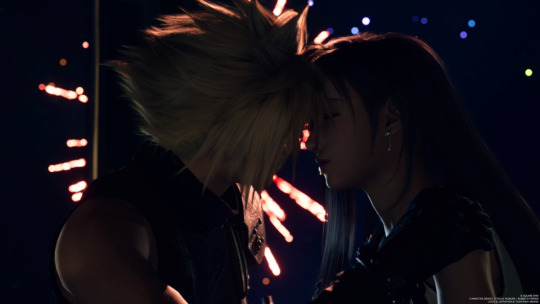
*disclaimer* it doesn’t matter if the moment is "optional". All of the dates are "optional" in that sense and all of them are narratively important. It is much more honest to consider the date "expanded" rather than "optional". They expand our understanding of the narrative and characters, not alter it.
Anyway, this moment of emotional relief is soon followed by the unraveling of Cloud’s mental state, marking the descent of Tifa's arc into its lowest point yet. The game transitions from the joy of the Gold Saucer to the Temple of the Ancients, where Cloud’s spiraling intensifies under Sephiroth's manipulation. Tifa is forced to watch as the man she loves loses control, and her devastation grows as she realizes how powerless she is to stop it.
The situation worsens at the Forgotten City, where not only does Cloud continue to deteriorate, but Tifa also witnesses the loss of Aerith, one of her closest friends. The combination of losing Aerith and seeing Cloud fall deeper into Sephiroth's influence leaves Tifa emotionally shattered, hitting rock bottom.
These events at the end of Rebirth set the stage for Tifa’s ultimate rise in Part Three. Her devastation, watching Cloud spiral and suffering the heartbreak of losing Aerith, pits her at the lowest emotional point in her journey. This is essential for unfolding her heroine arc in Part 3 (Disc Two of the original game), where she will be pivotal in the events at the Northern Crater, the escape from Junon, Mideel, and ultimately, the Lifestream scene.

The Lifestream scene is the culmination of Tifa’s entire arc—everything she has experienced in Remake and Rebirth has been preparing her for this moment. Despite the many challenges of the journey thus far - many of them internal - Tifa will be the one to guide Cloud back to his true self, using the deep emotional connection they've forged. It is here that her resilience, emotional strength, and faith in Cloud, despite everything that has happened, will solidify her as the heroine destined to play a critical role in not just Cloud’s recovery but in the party’s fight against Sephiroth.
In this way, Tifa’s underdog arc is not just about personal growth; it is about the power of emotional resilience in a world where traditional heroism is often defined by strength and cosmic or magical power, a core message of the game’s overall subversion. By the time she reaches her role in Part 3, Tifa will have transformed from someone who was dismissed and overshadowed into a heroine whose quiet strength proves to be indispensable.
Her journey, both in OG and FF7R, shows that true heroism often lies not in grand gestures but in emotional endurance and unwavering support for those who matter most - those we love.
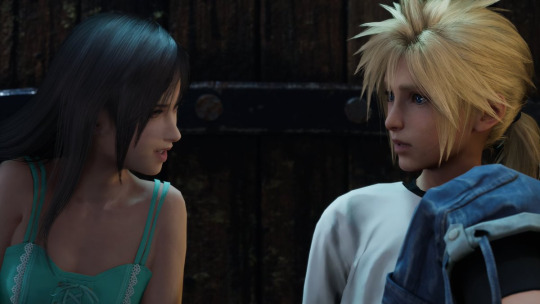
76 notes
·
View notes
Text
introductory excerpts on COINTELPRO
it came to my awareness that some folks don't know what COINTELPRO is still, so imma drop some excerpts from the wikipedia page. ofc there are a billion other resources you can check out, especially firsthand accounts, but this is always a good place to start! link attached below:
[Note that the embedded link above's photo has the following caption: "COINTELPRO memo proposing a plan to expose the pregnancy of actress Jean Seberg, a financial supporter of the Black Panther Party, hoping to "possibly cause her embarrassment or tarnish her image with the general public". Covert campaigns to publicly discredit activists and destroy their interpersonal relationships were a common tactic used by COINTELPRO agents."]
The Introduction:
COINTELPRO (syllabic abbreviation derived from Counter Intelligence Program; 1956–1971) was a series of covert and illegal[1][2] projects actively conducted by the United States Federal Bureau of Investigation (FBI) aimed at surveilling, infiltrating, discrediting, and disrupting domestic American political organizations.[3][4] FBI records show COINTELPRO resources targeted groups and individuals the FBI[5] deemed subversive,[6] including feminist organizations,[7][8] the Communist Party USA,[9] anti–Vietnam War organizers, activists of the civil rights and Black power movements (e.g. Martin Luther King Jr., the Nation of Islam, and the Black Panther Party), environmentalist and animal rights organizations, the American Indian Movement (AIM), Chicano and Mexican-American groups like the Brown Berets and the United Farm Workers, independence movements (including Puerto Rican independence groups such as the Young Lords and the Puerto Rican Socialist Party), a variety of organizations that were part of the broader New Left, and white supremacist groups such as the Ku Klux Klan[10][11] and the far-right group National States' Rights Party.[12]
Methods COINTELPRO Utilized
According to attorney Brian Glick in his book War at Home, the FBI used five main methods during COINTELPRO:
Infiltration: Agents and informers did not merely spy on political activists. Their main purpose was to discredit, disrupt and negatively redirect action. Their very presence served to undermine trust and scare off potential supporters. The FBI and police exploited this fear to smear genuine activists as agents.
Psychological warfare: The FBI and police used a myriad of "dirty tricks" to undermine movements. They planted false media stories and published bogus leaflets and other publications in the name of targeted groups. They forged correspondence, sent anonymous letters, and made anonymous telephone calls. They spread misinformation about meetings and events, set up pseudo movement groups run by government agents, and manipulated or strong-armed parents, employers, landlords, school officials, and others to cause trouble for activists. They used bad-jacketing to create suspicion about targeted activists, sometimes with lethal consequences.[74]
Harassment via the legal system: The FBI and police abused the legal system to harass dissidents and make them appear to be criminals. Officers of the law gave perjured testimony and presented fabricated evidence as a pretext for false arrests and wrongful imprisonment. They discriminatorily enforced tax laws and other government regulations and used conspicuous surveillance, "investigative" interviews, and grand jury subpoenas in an effort to intimidate activists and silence their supporters.[73][75]
Illegal force: The FBI conspired with local police departments to threaten dissidents; to conduct illegal break-ins in order to search dissident homes; and to commit vandalism, assaults, beatings and assassinations.[73] The objective was to frighten or eliminate dissidents and disrupt their movements.
Undermine public opinion: One of the primary ways the FBI targeted organizations was by challenging their reputations in the community and denying them a platform to gain legitimacy. Hoover specifically designed programs to block leaders from "spreading their philosophy publicly or through the communications media". Furthermore, the organization created and controlled negative media meant to undermine black power organizations. For instance, they oversaw the creation of "documentaries" skillfully edited to paint the Black Panther Party as aggressive, and false newspapers that spread misinformation about party members. The ability of the FBI to create distrust within and between revolutionary organizations tainted their public image and weakened chances at unity and public support.[49]
The FBI specifically developed tactics intended to heighten tension and hostility between various factions in the black power movement, for example between the Black Panthers and the US Organization. For instance, the FBI sent a fake letter to the US Organization exposing a supposed Black Panther plot to murder the head of the US Organization, Ron Karenga. They then intensified this by spreading falsely attributed cartoons in the black communities pitting the Black Panther Party against the US Organization.[49] This resulted in numerous deaths, among which were San Diego Black Panther Party members John Huggins, Bunchy Carter and Sylvester Bell.[73] Another example of the FBI's anonymous letter writing campaign is how they turned the Blackstone Rangers head, Jeff Fort, against former ally Fred Hampton, by stating that Hampton had a hit on Fort.[49] They also were instrumental in developing the rift between Black Panther Party leaders Eldridge Cleaver and Huey Newton, as executed through false letters inciting the two leaders of the Black Panther Party.[49]
...
In order to eliminate black militant leaders whom they considered dangerous, the FBI is believed to have worked with local police departments to target specific individuals,[78] accuse them of crimes they did not commit, suppress exculpatory evidence and falsely incarcerate them. Elmer "Geronimo" Pratt, a Black Panther Party leader, was incarcerated for 27 years before a California Superior Court vacated his murder conviction, ultimately freeing him. Appearing before the court, an FBI agent testified that he believed Pratt had been framed, because both the FBI and the Los Angeles Police Department knew he had not been in the area at the time the murder occurred.[79][80]
...
In 1969 the FBI special agent in San Francisco wrote Hoover that his investigation of the Black Panther Party had concluded that in his city, at least, the Panthers were primarily engaged in feeding breakfast to children. Hoover fired back a memo implying the agent's career goals would be directly affected by his supplying evidence to support Hoover's view that the Black Panther Party was "a violence-prone organization seeking to overthrow the Government by revolutionary means".[84]
Hoover supported using false claims to attack his political enemies. In one memo he wrote: "Purpose of counterintelligence action is to disrupt the Black Panther Party and it is immaterial whether facts exist to substantiate the charge."[85]
Intended Effects of COINTELPRO
The intended effect of the FBI's COINTELPRO was to "expose, disrupt, misdirect, or otherwise neutralize" groups that the FBI officials believed were "subversive"[58] by instructing FBI field operatives to:[59] 1. Create a negative public image for target groups (for example through surveilling activists and then releasing negative personal information to the public) 2. Break down internal organization by creating conflicts (for example, by having agents exacerbate racial tensions, or send anonymous letters to try to create conflicts) 3. Create dissension between groups (for example, by spreading rumors that other groups were stealing money) 4. Restrict access to public resources (for example, by pressuring non-profit organizations to cut off funding or material support) 5. Restrict the ability to organize protest (for example, through agents promoting violence against police during planning and at protests) 6. Restrict the ability of individuals to participate in group activities (for example, by character assassinations, false arrests, surveillance)
When did they start?
Centralized operations under COINTELPRO officially began in August 1956 with a program designed to "increase factionalism, cause disruption and win defections" inside the Communist Party USA (CPUSA). Tactics included anonymous phone calls, Internal Revenue Service (IRS) audits, and the creation of documents that would divide the American communist organization internally.[9] An October 1956 memo from Hoover reclassified the FBI's ongoing surveillance of black leaders, including it within COINTELPRO, with the justification that the movement was infiltrated by communists.[31] In 1956, Hoover sent an open letter denouncing Dr. T. R. M. Howard, a civil rights leader, surgeon, and wealthy entrepreneur in Mississippi who had criticized FBI inaction in solving recent murders of George W. Lee, Emmett Till, and other African Americans in the South.[32] When the Southern Christian Leadership Conference (SCLC), an African-American civil rights organization, was founded in 1957, the FBI began to monitor and target the group almost immediately, focusing particularly on Bayard Rustin, Stanley Levison, and eventually Martin Luther King Jr.[33]
How did the news get out about COINTELPRO?
The program was secret until March 8, 1971, when the Citizens' Commission to Investigate the FBI burgled an FBI field office in Media, Pennsylvania, took several dossiers, and exposed the program by passing this material to news agencies.[1][54] The boxing match known as the Fight of the Century between Muhammad Ali and Joe Frazier in March 1971 provided cover for the activist group to successfully pull off the burglary. Muhammad Ali was a COINTELPRO target because he had joined the Nation of Islam and the anti-war movement.[55] Many news organizations initially refused to immediately publish the information, with the notable exception of The Washington Post. After affirming the reliability of the documents, it published them on the front page (in defiance of the Attorney General's request), prompting other organizations to follow suit. Within the year, Director J. Edgar Hoover declared that the centralized COINTELPRO was over, and that all future counterintelligence operations would be handled case by case.[56][57]
#reaux speaks#black panther party#fbi corruption#cointelpro#counterinsurgency#revolution#martin luther king jr#black power#intersectional feminism#indigenous#young lords#history#wikipedia#communism#socialism#j edgar hoover#mccarthyism
379 notes
·
View notes
Note
anon w/ the writing questions: not pretentious at all!! If anything i find that having a creative outlet is a double edged sword wherein the layman will look at you and roam around searching for the insane asylum you escaped from & the fellow artist will always eye you with skepticism & as not taking the craft seriously enough (i only ever get this since im not a writer by “trade”). But anyways, back to your comments, thank you!!! I appreciate them, i did wanna dig into why you dont think of your fanfic work doesnt work the same muscle as fiction? I can see somewhat where fanfic is almost like doing a fancy coloring book, it looks nice and the lines are all filled in but the lines were already drawn on the page for you. What do you think? Does fanfic really not exercise/fulfill the same creative itch as og work?
yeahh so to me fanfic is different to fiction mainly because 1) it isnt original. evergreen statement but ideas out of thin air are just generated differently than ideas within an existing framework. it fulfils a creative itch but a different one— you have to be thinking about the nooks and crannies of the original work (which in some ways is more akin to criticism lol) and you are contained by those margins. i compared it to a puzzle— which yeah, if it’s anything, it’s a thought experiment. if you change one thing (the degree of care between characters, the setting, the outcome of a canon event, etc) how do the other dominoes fall? that’s what’s exciting about it. it’s a dialogue, it’s play!
and 2) the stylistic conventions are totally different. straight up, it is not expected to be as polished or particularly voice-y. there are more paragraph breaks, usually more scene breaks, less attention to setting because it’s already familiar to us. cliche is not only acceptable but also a central part of the experience— including often the subversion of cliche! fic will often mimic the voice and style of the original work, but just as often the fun comes in contrasting it— a medical jargon show lifting into intense emotive language, or a big flashy movie dwelling on small minutiae. ntm everyone who approaches it has a sort of “just for fun” exploratory attitude that can overlook elements of style that would bother a fiction audience. like if i’m writing fanfic and im being repetitive or purple prosey or tonally off i’ll just ignore it and keep it in because i’m having fun and playing around and it’s not that serious lol. and because it’s a dialogue, its ‘theme’ is often a response to or elaboration on a theme of the original work too. it’s rare that fanfic will have its own totally original and separate “ideas about the world” that fiction is expected to have. it’s just not about you!
(in this way i sometimes think fiction is more ‘self indulgent’ than fanfic. fanfic (and the shaping of its conventions fandom by fandom) is necessarily a communal activity and cannot stand on its own, and it’s written with a very specific small well defined audience in mind. it’s in service to the source. fiction has influences and works in dialogue with other works, but it is also centrally about Your ideas and Your voice and what You think is important. you have to have a Perspective and be secure enough in it to want to express it to a wide audience! that’s what makes it a “higher art” in the first place.)
#i didnt realize i had this many thoughts about it.#i do think fanfic excercises A muscle of fiction— namely just Generating Content. figuring out how to move scene by scene#it’s practice.. but only for a very specific part of writing#i do also think the reflexive approach of fic might help abstractly. being able to write in different styles depending on#what would be effective. thinking about what makes up that style and how to apply or subvert it#makes you more aware of those elements in your original work
12 notes
·
View notes
Text
{current Active verses with certain ppl}
My main verse with my overreaching blog story of expanding the rings and my world building of hell : Radioapple main, with @voodoodaaddy , @letsstaytuned and @heaven-saidx (gabe come meet ur nephew lol)
Sub verse of this is Royalstag verse : with @hellsmusing and @voodoodaaddy with twins on the way! ( if u want to join these verses plz talk to my partners about it as well we are a package deal I believe lol )
Angelicradio verse : Sammy meets Al and they are adorable and sweet and sad and radioapple in every au plz . With @voodoodaaddy
Default Main verse aka Hotel life: for those new to the blog or undecided stuff /anything with the sins and side au’s, it’s post season 1, Lucifer is staying both at the hotel and palace Lilith is still not back home ,this can also house subverses and events such as the Octavia Morningstar verse with @a-hell-of-a-time , and various other events, basically this is the fall back verse for any other interactions and dash coms unless stated otherwise .
Concertina Ballerina: ( sub default main verse) with @indulgentnine ‘s Vel, who’s lost her soul to Lucifer and is now his plaything/ jester as a punishment and for his amusement .
Samuel’s multiverse adventure : basically anything with Samuel /prefall verse or heaven’s design team au that’s undecided or funny dash stuff .
Draglitz verse: Blitzø and Lucifer are the best clown dads and their ship is gonna rock ur world and cause several natural disasters ! Extremely fun and awesome ship/verse with my Irl bestie Liz ~ @blitzbuckz
————
{ depending on the partner dash com stuff may or may not reflect these verses or just be stand alone things }
Simple funny stuff between me and those above can be counted as part of the verse or just funny things between us .
——————
Other verse that has its own story ( ?) not associated with my overall blog story Unless they want it to be .( can have my worldbuilding tho)
Morningstar meet up verse : whatever random story line is between my Lucifer and @cast-you-dxwn ‘s mike and @hellsdisneyprincess and the muns Raphael and multi muse . ( other blogs in this verse maybe ?? ) @mourningstarred @heaven-saidx @avispatr
The Hannah verse lol : random storylines between @the-smallest-star and I that can be tied to my default main since that’s mainly a blank slate verse . Others might be included in this such as @queen-of-prophecy and any of Hannah’s moots .
Truces and mannquiens verse: mainly just pure crack nothing serious at all random shit between me and @originemesis lol
Shared Roo / Yahabel being the best sister in law ever verse: is anything between me and @sanctumpyre and @sanctusworn ( Yahbel gonna get these two bros back together again I swear <3 )
Mechanical Angel verse : angelic tv verse with @voxiiferous Sam ends up in hell oh no lol
Undecided stuff : things between me and @danger-tits-lute and @dick-meister unsure where to put these yet but I love them so much .
Dash stuff is most likely gonna reflect these verses here as well as my default main .
#gonna make this a page on my blog#just getting stuff organized#current active verses#verses#ooc#blog lore
18 notes
·
View notes
Text
🔥🔥🔥Vigilant Observer Edmond's R2 is UNDER-RATED!!!!!🔥🔥🔥 (a self-indulgent long-ass Edssay defending a room I really REALLY liked)
So, I have seen a weirdly large amount of comments online saying that the new SSR Edmond's Intimacy Room 2 sucks. I've seen it called boring and a waste of intimacy gifts.
Peace and Love, I know everyone has different tastes---and I am hella biased towards Edmond---
BUT!!!
I believe any perceive shortcomings are completely out-weighed by the elements this room actually focuses on.
At the very least, this intimacy room DESERVES to be appreciated more, rather than ruthlessly slandered.
1) What Happens VS What Doesn't
Here's a very general outline of what happens in R2:
Eiden initiates a "Guard searching/punishing a Prisoner" scene (Roleplay)
Eiden provokes (/ is a Brat to) Edmond (Dom/Sub)
Edmond use essence to conduct electricity into the baton, and uses the electricity to stimulate his exposed skin and dick (Electroplay + Masochism)
Eiden's provocations eventually turn into teasing (Dirty Talk, + light Humiliation)
Eiden uses the top of his foot to rub Edmond's bulge through his pants
Edmond cums first; Eiden teases/provokes him for it
Eiden cums shortly after from the Electroplay
Perfectly normal, standard intimacy room, yes?
But, from what I've gathered, people are labelling it as boring or under-whelming because:
There isn't any Bondage
There isn't significant nudity/direct skin-to-skin touching
The areas that are touched are relatively small (basically just each character's groin)
Edmond isn't the one that gets off from Masochism (or at least, not from physical Masochism)
These points go against what people's EXPECTATIONS were; since the setting of this event was in inside a prison--a harsh environment full of rough individuals and literal bondage--they expected this R2 to be more physical and rough than it actually was.
Hell, even I wasn't expecting for the room to be as "tame" as it was.
But just because my expectations were subverted doesn't mean I got pissy about it.
BECAUSE THIS ROOM IS STILL FUCKING GOOD!!!
I think a lot of people are ignoring the fact that not all BDSM plays NEED Bondage, skin-to-skin, physical pain (in this case, just on Ed's part), etc. to be satisfying--just because they expected that but didn't get it.
2) Missing the Point - THIS ROOM IS STILL HELLA KINKY (A Closer Look at Ed's Satisfaction)
If you're seeing this post, there's a fair chance you've also seen my GIANT Edmond Post for Struggling Fanfic Writers; which is basically a long-ass character analysis of Edmond.
As I mentioned in that post, Edmond H-scenes have certain themes/kinks that re-occur; and as it turns out, the Intimacy Room we'll be looking at today features a lot of them.
However, for the purposes of this post, I'm going to narrow it down to just 2--the 2 that, in my opinion, were the main contributors towards Edmond's orgasm. (After all, the quality of intimacy rooms with each unique character relies on the quality of that character's experience.)
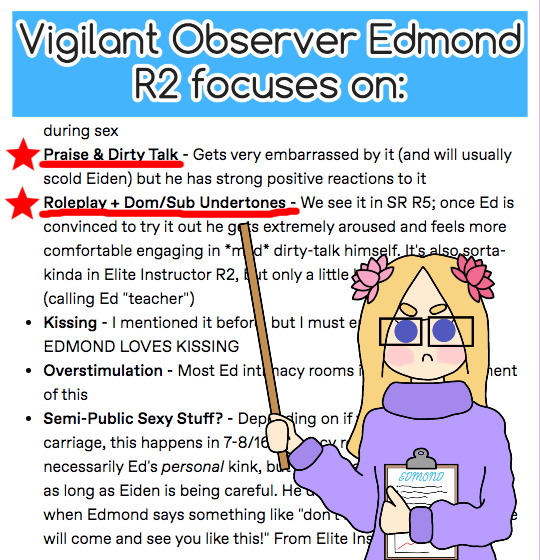
The quality with which these themes/kinks are executed is extremely impressive, which is why it was satisfying to the characters; and thus, satisfying for us players to watch.
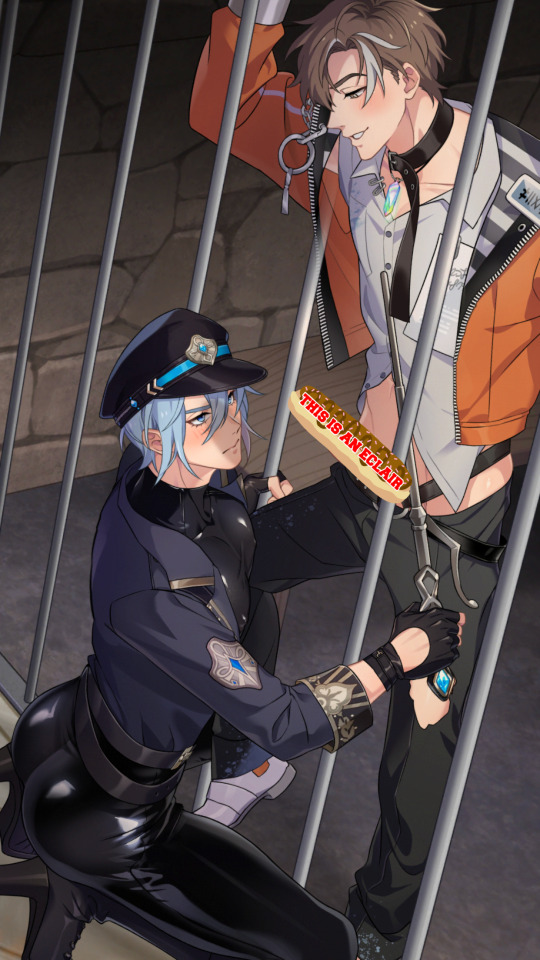
(I have censored this image in the hopes that Tumblr won't snipe me)
When R2 starts, Eiden immediately sets the scene by provoking Edmond; saying that Edmond should do is job as a guard and properly search the prisoner.
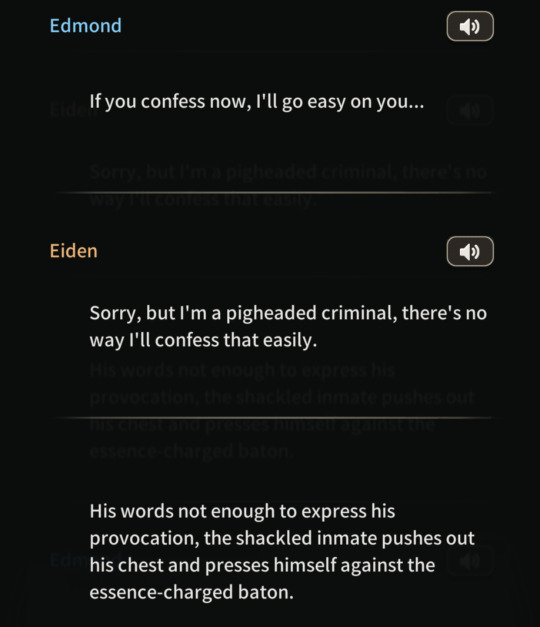
Via Eiden's provocations, although Edmond is in a vulnerable position--kneeling on the ground--he is, for the moment, playing the Dominant role.
This is another subversion of expectations, which I find very welcoming. This is possibly the closest we've ever gotten to characters switching roles--only, Edmond doesn't actually "top." (Though, now that I think of it, Silver Confessor Olivine R5 also has a similar dynamic....*shrug*)
While Edmond is acting as a Dom, Eiden is a Bratty Submissive; saying things like "it feels like a tickle!" when Edmond starts electrifying the baton.
Edmond is surprised when Eiden gets excited by being treated in such a degrading way (I spy, with my little eye, PROJECTION); but he's shortly thereafter put into a degrading position himself---
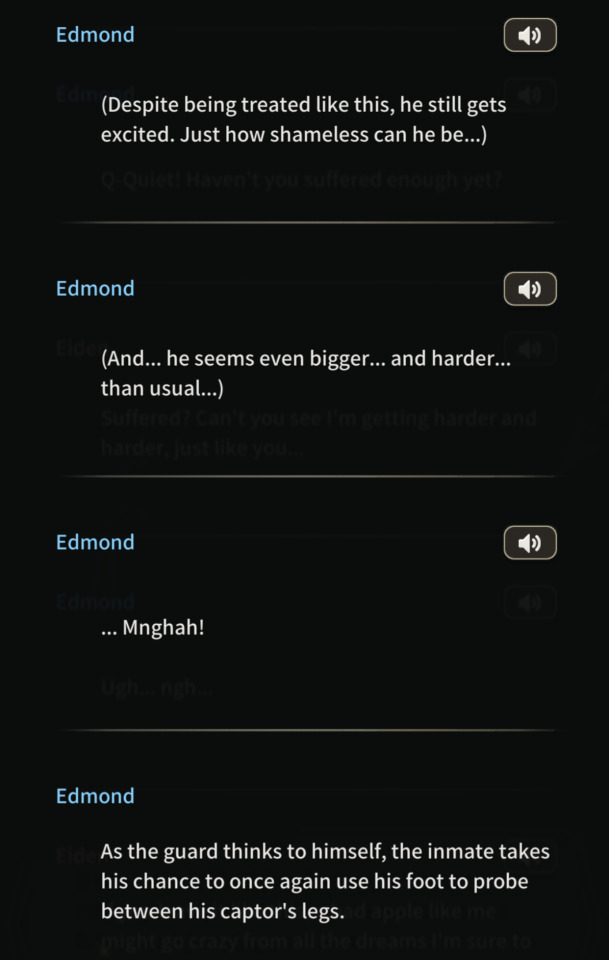
This is when Eiden starts rubbing Edmond through his pants with the top of his foot--which honestly isn't far off from the whole stepping-on-others position that is common in BDSM.
If you ask me, this is a HUGE POINT contributing towards the quality of this room: This submissive position, symbolizing Edmond's gradual loss of power/control.
Eiden also teases Edmond in the hopes that he'll suck him off; but, staying in-character, Edmond refuses him.
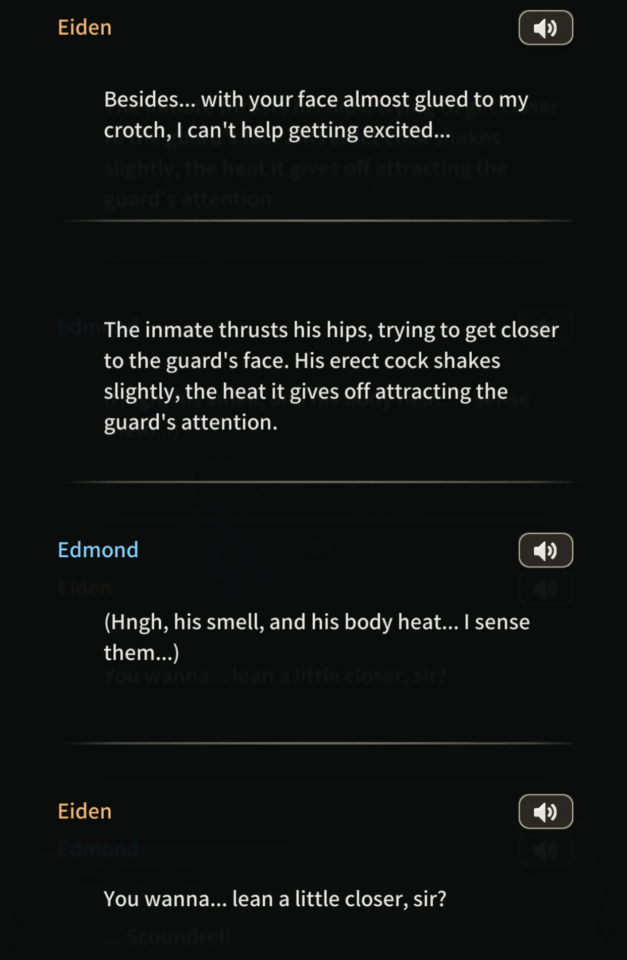

In other words, not giving Eiden head--another expectation people had that wasn't fulfilled--was literally a part of the play. It's Sexual Denial.
But, as R2 goes on, Eiden's teasing and dirty talk get more and more intense, and it basically ends up switching their roles in this play.
You know how in a typical Edmond H-scene, Eiden's kissing, caressing, etc. gradually make Edmond lose his mind with how horny he gets?
Well, so far, literally the only thing Eiden has done is indirectly rub his bulge. Rather than physical touch, Eiden's dirty talk is what makes Edmond the most aroused.
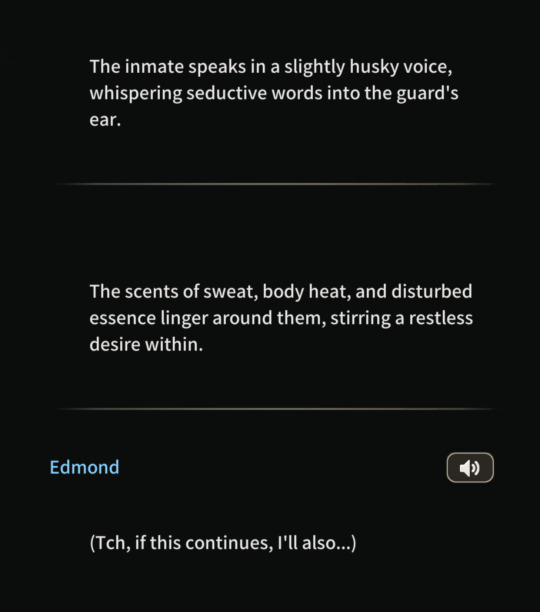
DEADASS---EIDEN DOESN'T EVEN HAVE TO DO THAT MUCH. HE DOES SUCH A GOOD JOB RILING EDMOND UP JUST WITH HIS WORDS, THAT THIS HAPPENS:
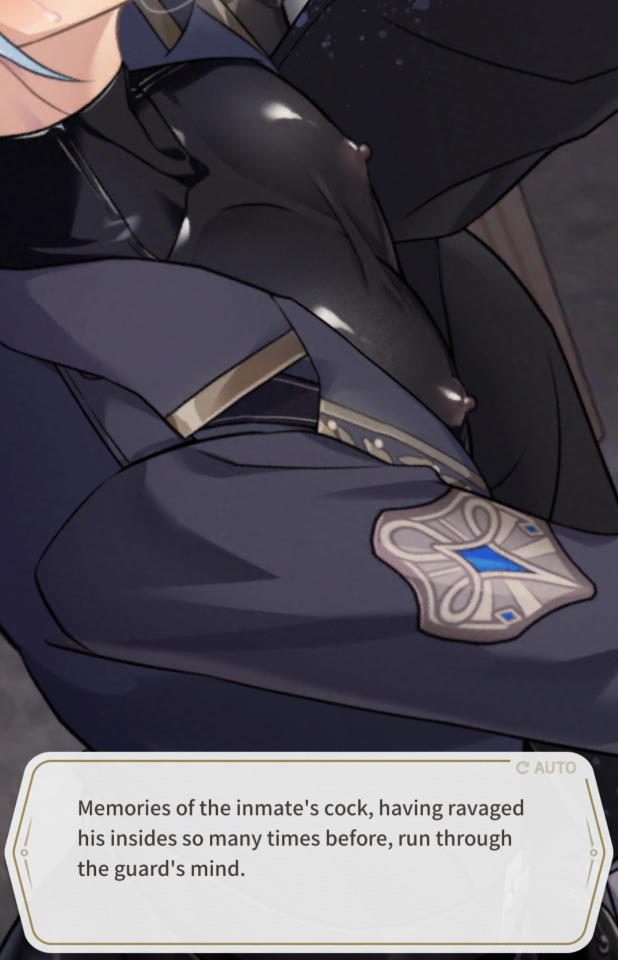

BITCH, EDMOND'S NIPPLES GET ERECT ON THEIR OWN!!!! JUST FROM HOW TURNED ON HE IS!!!! WITHOUT THEM EVER BEING TOUCHED!!!! THAT HAS LITERALLY NEVER HAPPENED BEFORE!!!!!!!!!
All Eiden has to do to fully switch Edmond from the Dom position back into the Sub--making Edmond lose control over himself--is TALK.
THAT IS SO FUCKING SEXY, WHAT THE HELL???? ♡♡♡

This is why I DO NOT UNDERSTAND people that don't like this room.
I've said before--in the GIANT Ed-Post--that Edmond is sensitive. And his H-scenes do a great job of showing that off---via PHYSICAL TOUCH.
But what this intimacy rooms excels at is expressing how Edmond is sensitive to more than just physical touch.
AND THAT IS THE WHOLE DAMN POINT!!!
Let's look again at the evidence:


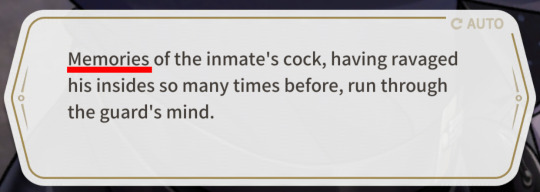
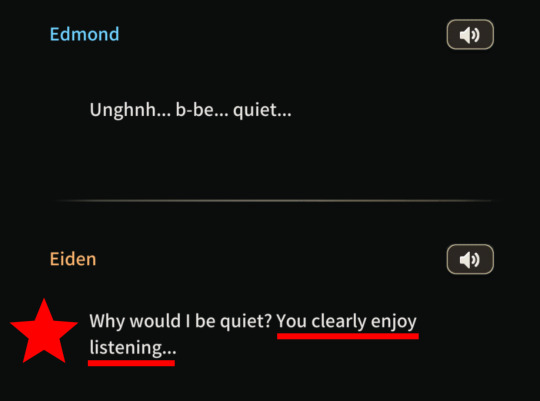
Listen. I know this intimacy room didn't have the play people were expecting.
BUT IT WAS STILL GOOD.
Speaking from personal experience--and from the obvious arousal and satisfaction Edmond shows in this room--not every BDSM play needs to be super physical. Submission/masochism is not exclusively about physical stimulation/pain.
What we see in this intimacy room is Edmond being dominated in a psychological way, and that's what makes is so damn kinky and rewarding; both for viewers and for Edmond.
3) The GOD-TIER Technical Aspects
...So...did the people that are heavily criticizing this R2 just, like, have their sound off the whole time??? Or did they only read the subtitles without looking at the actual visuals of this intimacy room??????
Even if, for whatever reason, the find the scenario under-whelming, I CANNOT FOR THE LIFE OF ME picture a situation where the voice-acting and animation couldn't make up for that.
Quickly referencing back to the last section of this Edssay; Eiden is teasing Edmond like the entire time, and that "slightly husky" and "seductive" voice is INCREDIBLE. An absolute TREAT for my ears. And Edmond's panting, gasps, and moans???? HOT DAMN.
These two could be doing the most mundane, "boring" sexual act ever, but if we can hear that the both of them are clearly very into it, then why wouldn't it be a satisfying intimacy room???
And then there's the art---

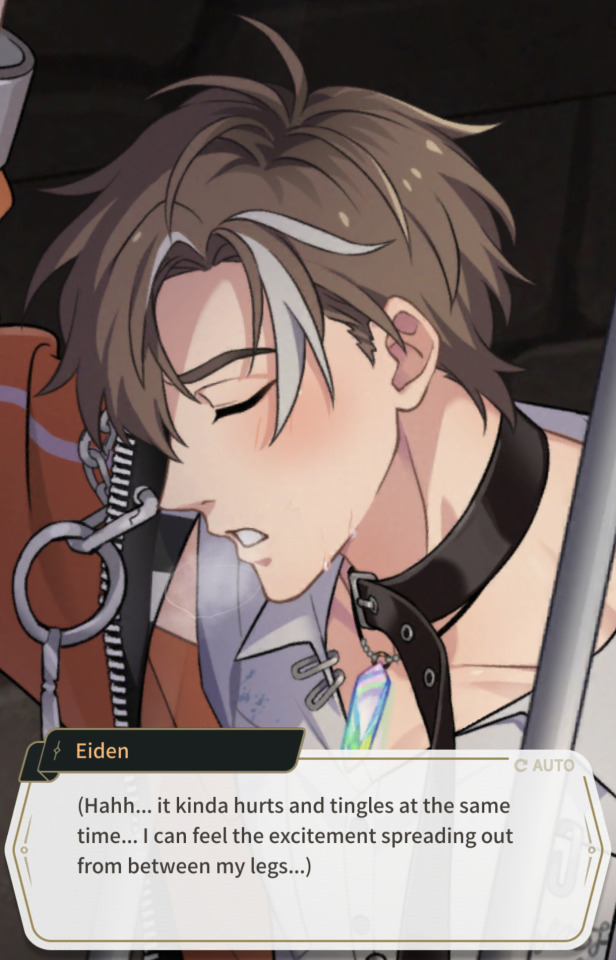

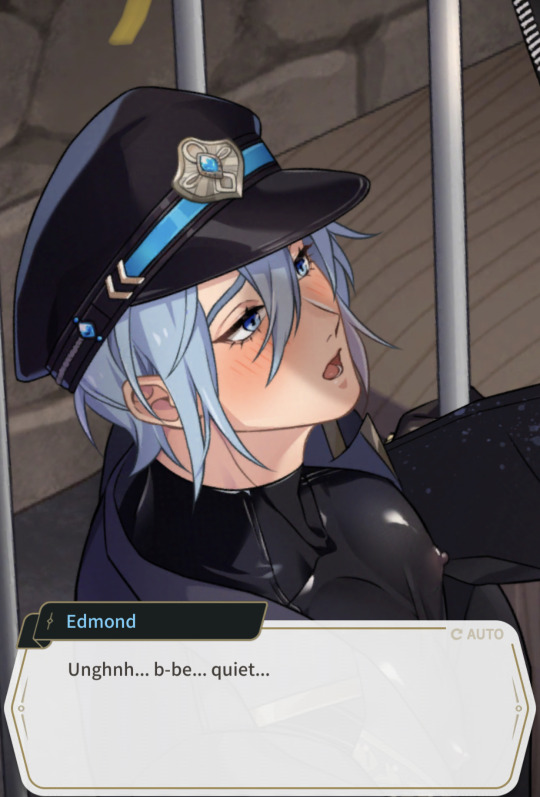

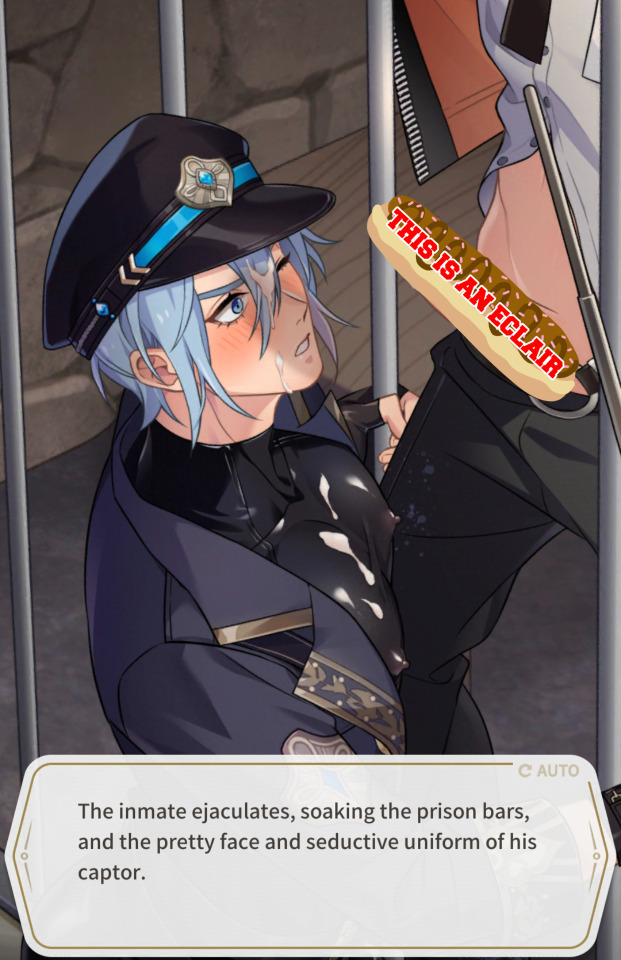
It's all just SO GOOD, DAMMIT!!!!
4) ╭∩╮(˶ᵔ ᵕ ᵔ˶)╭∩╮♡
I know that this Edssay was unnecessary. I know I spent too much time on it. I know that there's a high likelyhood no one will read it.
And, of course, I know that everyone is entitled to their own opinions.
BUT WHEN THOSE OPINIONS ARE BASED ON SILLY-ASS REASONS, AND END UP SLANDERING MY BOI EDMOND????
AND WHEN THOSE OPINIONS ARE JUST OBJECTIVELY WRONG??? (Peace and love)
I CANNOT, AND WILL NOT, STAY SILENT!!
I WILL PUT A STUPID AMOUNT OF TIME AND EFFORT INTO SCREAMING ABOUT WHY THAT OPINION IS HELLA MISGUIDED, AND I WILL SCREAM INTO THE VOID ABOUT IT!!!!
,; (ง 🔥 ロ 🔥 )ง ;,
...
.....
..........
This intimacy room was good, dammit....
Stop being so mean to it......
(⸝⸝o̴̶̷᷄-o̴̶̷̥᷅⸝⸝)
#nu carnival#nu: carnival#nu carnival edmond#edmond is love edmond is life#no one asked for this but i did it anyway
52 notes
·
View notes
Text
WHite Hair and Trauma Brawl Round 1; Poll 73
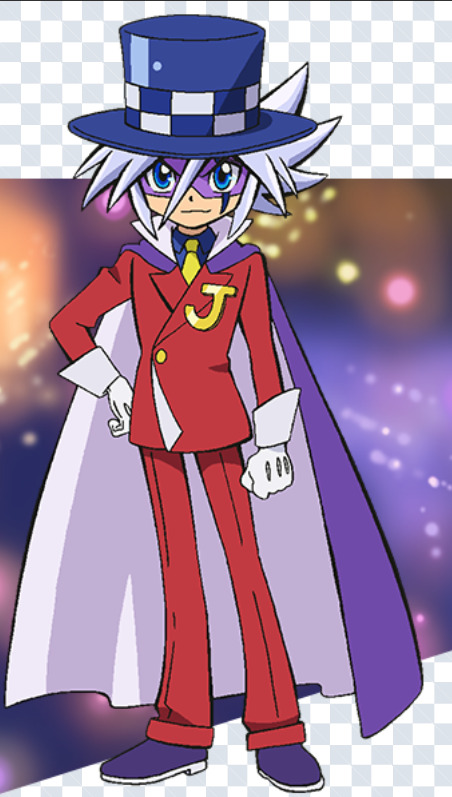

remember, voting is based on swag, trauma, and favoritism!!
trauma and propaganda under the cut!
Trauma!
Joker: Hoo boy; this is massively spoilery but. He was orphaned at a young age, left alone in his family's mansion for months before some evil asshole breaks in in order to rob him, and tries to kill him repeatedly, even in the one instance he's compliant (which he very much was Not, initially). If it wasn't for some other guy (who also technically came there to rob him), he'd've died. Instead he winds up saving this kid's life, causing him to literally sneak onto a biplane and declare himself this guy's apprentice, pretty much. And this is just the the origin story! Later on, that same evil asshole will cause Multiple problems later on in his life, both in direct and indirect ways (this evil guy basically has a hobby of orphaning children and ruining people's lives, tho funnily enough he might not be the cause of this particular orphaning; it's never clarified if he did do it or didn't, but he certainly orphaned some of Joker's friends, so). There's a lot more over the course of the series, but I don't want to spoil too much (or go into too much detail). It's a series for elementary school-aged children, so it's not really explored in too much detail; but it's clear that there is Something distinctly wrong with this kid if you pay close enough attention in certain scenes. Plus requisite orphan angst, lol. This is mostly in reference to the anime adaptation, but the manga has some of this in it, too, including the one evil dude trying to kill him and then coming back later to kill him again, as well as being an indirect cause of Yet Another Guy who's trying to kill him (tho in both adaptations it's a bit more complicated than that).
Kochi: Kochi was born as a product of incest due to an experiment his father was performing to strengthen the concentration of a genetic disease called ZENO. His mother, trying to protect him, tried to make sure that his father never met Kochi and wouldn't be able to hurt him. However, one day, he came to their house. Kochi's mother told him to run to his room and absolutely not come out, and then yelled at his father and condemned his plans to spread the genetic disease. He murdered her for showing that she knew his plans, and when Kochi came out of his room, he saw his dead mother and his father standing over her. His father then cornered him against the door, and Kochi, fearing for his life, split an alter known as Watashi (because Kochi himself used Boku as a personal pronoun) to run from the memory of the event. From then on, Kochi and Watashi tended to both run their life, though Watashi would influence Kochi's memories to fill in the blanks so that he wouldn't notice. Later in childhood, Kochi's hair is seen as being white, even though it was originally black, and remains that way. He was always bullied by his peers for being parentless and alone, but he always laughed and played alone, saying he didn't mind it. Watashi, unable to speak to Kochi directly, always mourned that Kochi had to be alone and wished that he could have friends. This allows their father to manipulate them into becoming the figurehead of a cult glorifying ZENO on the promise that Kochi will have friends there, and they began to live underground, where they would be around corpses as part of their cannibalism-glorifying cult.
Propaganda!
Joker: A bit of a subversion of the trope, with a carefree personality that wouldn't suggest that he has any sort of trauma at all. Granted, being a comedy series for 8-10 year olds, it wouldn't be very entertaining if he was shown being sad all the time, now would it? But, while subtle in many cases, plenty of the signs are still there; and in some cases they all but bludgeon you in the face with it. Also, a lot of people are gunning for this guy's head- tho that might have something to do with his career choice (a phantom thief). Plus he's just such a funny silly goofy guy; I love funny silly goofy guys, especially when they come with barely disguised heavy personal baggage. Also, he has a debilitating fear of cats, presumably domestic cats specifically; it's regularly played as just a joke, but since the anime adaptation in particular actually gave him a traumatic incident in his childhood to incite the fear in the first place, it's actually kind of messed up that everyone who meets him and learns about it immediately makes fun of him for it. It's not like they KNOW, most of the time anyways; but even still, it's a pretty messed-up and mean-spirited thing to do. (Tho, it's an adaptation from the early to mid-2010's of something that started its run in the late 2000's, so some of the jokes are bound to have aged rather poorly. There's worse examples but they have nothing to do with the trauma specifically and so are irrelevant here.) There's a LOT more I could say, involving perilous situations, near-death, assumed-death, and even ACTUAL death (and that's not just about him being an orphan); but I don't want to spoil too much. Let's just say that this mostly cute and comical series loves to sometimes smack you in the face with the emotional equivalent of a skillet.
[Kochi did not receive propaganda. rip.]
6 notes
·
View notes
Text
Diana Theory part 1/2
Chapter 1 was filled with numerous subverted expectations, that kept me at the edge of my seat up until the end. One of these subversions that I stumbled across, was when Diana was accused of murdering Wolfgang about halfway in. Throughout the segment, viewers of the stream or players had likely come in with the suspicion that Diana would be a figure of suspicion in someway or another. Many theories had often pinned Diana to be a killer, mastermind or some sort of traitor. But the trial perfectly goes against these theories as Damon starts having doubts about suspecting Diana. But even though the suspicion was intended to be pinned towards her, she is eventually revealed to be completely innocent. But deliberately hid the truth, and her position in Wolfgang's death. From this chapter and the Free Time Events, I started to theorize that Diana may suffer from some sort of trauma in the past. Whether it was likely from becoming one of the popular girls at school, or getting to where she is, in her field of talent. Diana doesn't like to talk about herself. Currently, I have a suspicion that Diana might have have trust or abandonment issues. And as a byproduct of getting ahead and becoming the Ultimate Cosmetologist, Diana may have either lost some good friends. Or a nasty rumour about her circulated, from being part of the popular group as described in her official bio. In the bio it was stated that 'being friends with the popular group in her school has its advantages'. Nothing was stated about the possible consequences of either being associated with them (presuming the popular group wasn't very supportive or anything) or what Diana may have potentially needed to do to become the Ultimate Cosmetologist. There is a possibility that Diana acted like a different person in the past, likely in order to gain favour or attention from the popular group. Or somewhere in the friend circle, Diana may have gotten exposed to unfriendly interactions which may cause Diana to suppress herself and refrain from talking about herself. Likely done in order to appease the popular teens and potential clients. Both the second Free Time Event and the first trial explores Diana's hesitation to speak up or say anything. Even though hiding the truth only drew suspicion on her, she didn't want to be framed for being the killer either. It took Damon to reach out in both the logos and pathos routes. Even though they both sounded differently. In Pathos, Damon says he promises to hear her out, even in the midst of the fear and chaos that came up as a result of his accusations. And likely from being promised that she would be heard, did Diana speak up.
#diana venicia#diana x damon#project eden's garden#project: eden's garden#dianmon#fan theory#3am thoughts#part 1/2#damon maitsu
18 notes
·
View notes
Text
It ain't over til the bisexual speaks...
The March on Washington for Lesbian, Gay, and Bisexual Equal Rights and Liberation took place on the 25th of April 1993 in Washington, D.C. An estimated 80,000 to over 1 million people attended.
The 1993 March was the first March on Washington to include bisexuals in the title. Out of 18 chosen speakers, only one was bisexual: Lani Ka'ahumanu.
Afterwards, she wrote an article for bisexual magazine Anything That Moves about her experience entitled "How I Spent My Two Week Vacation Being a Token Bisexual", which can be read on her website here.
The webpage also contains a transcript of the speech she made at the event, which has been copied below the cut:
Aloha, my name is Lani Ka’ahumanu, and it ain’t over til the bisexual speaks...
I am a token, and a symbol. Today there is no difference. I am the token out bisexual asked to speak, and I am a symbol of how powerful the bisexual pride movement is and how far we have come.
I came here in 1979 for the March on Washington for Lesbian and Gay Rights.
I returned in 1987 for the March on Washington for Lesbian and Gay Rights.
I stand here today on the stage of the 1993 March on Washington for Lesbian, Gay and Bisexual Equal Rights and Liberation.
In 1987 I wrote an article on bisexuality for the Civil Disobedience Handbook titled, “Are we visible yet?”
Bisexual activists organized on the local, regional and national levels to make this March a reality.
Are bisexuals visible yet? Are bisexuals organized yet? Are bisexuals accountable yet?
You bet your sweet ass we are!
Bisexuals are here, and we’re queer.
Bisexual pride speaks to the truth of behavior and identity.
No simple either/or divisions fluid – ambiguous – subversive bisexual pride challenges both the heterosexual and the homosexual assumption.
Society is based on the denial of diversity, on the denial of complexity.
Like multiculturalism, mixed heritage and bi-racial relationships, both the bisexual and transgender movements expose and politicize the middle ground.
Each show there is no separation, that each and everyone of us is part of a fluid social, sexual and gender dynamic.
Each signals a change, a fundamental change in the way our society is organized.
Remember today.
Remember we are family, and like a large extended family, we don’t always agree, don’t always see eye to eye.
However, as a family under attack we must recognize the importance of what each and every one of us brings to our movement.
There is strength in our numbers and diversity. We are every race, class, culture, age, ability, religion, gender identity and sexual orientation.
Our visibility is a sign of revolt.
Recognition of bisexual orientation and transgender issues presents a challenge to assumptions not previously explored within the politics of gay liberation.
What will it take for the gayristocracy to realize that bisexual, lesbian, transgender, and gay people are in this together, and together we can and will move the agenda forward.
But this will not happen until public recognition of our common issues is made, and a sincere effort to confront biphobia and transphobia is made by the established gay and lesbian leadership in this country.
The broader movement for our civil rights and liberation is being held back.
Who gains when we ostracize whole parts of our family? Who gains from exclusionary politics?
Certainly not us...
Being treated as if I am less oppressed than thou is not only insulting, it feeds right in to the hands of the right wing fundamentalists who see all of us as queer.
What is the difficulty in seeing how my struggle as a mixed race bisexual woman of color is intimately related to the bigger struggle for lesbian and gay rights the rights of people of color and the rights of all women?
What is the problem?
This is not a competition.
I will not play by rules that pit me against any oppressed group.
Has the gayristocracy bought so far in to the either/or structure, invested so much in being the opposite of heterosexual that they cannot remove themselves that they can’t imagine being free of the whole oppressive heterosexist system that keeps us all down?
Bisexual, gay, lesbian, and transgender people who are out of the closet, who are not passing for anything other than who and what we are all have our necks and our lives on the line.
All our visibility is a sign of revolt.
Bisexuals are here to challenge the bigots who have denied lesbian, gay and bisexual people basic civil rights in Colorado.
Yes, Amendment 2 includes bisexual orientation.
Yes, the religious right recognizes bisexuals as a threat to “so called” family values.
Bisexuals are here to protest the military ban against lesbians, gays and bisexuals.
Yes, the Department of Defense defines bisexuals separately as a reason to be dishonorably discharged.
And yes, out bisexuals are not allowed to be foster or adoptive parents,
And yes, we lose our jobs, our children, get beaten and killed for loving women and for loving men.
Bisexuals are queer, just as queer as queer can be.
Each of us here today represents many people who could not make the trip.
Our civil rights and liberation movement has reached critical mass.
Remember today.
Remember that we are more powerful than all the hate, ignorance and violence directed at us.
Remember what a profound difference our visibility makes upon the world in which we live.
The momentum of this day can carry us well into the 21st century if we come out where ever and when ever we can.
Remember assimilation is a lie. It is spiritual erasure.
I want to challenge those lesbian and gay leaders who have come out to me privately over the years as bisexual to take the next step, come out now.
What is the sexual liberation movement about if not about the freedom to love whom we choose?
I want to encourage bisexuals in the lesbian, gay and heterosexual communities to come out now.
Remember there is nothing wrong with love. Defend the freedom to express it.
Our visibility is a sign of revolt. We cannot be stopped. We are everywhere. We are bisexual, lesbian, gay and transgender people.
We will not rest until we are all free;
We will not rest until our basic human rights are protected under federal law;
We will not rest until our relationships and families are not just tolerated but recognized, respected and valued;
We will not rest until we have a national health care system; We will not rest until there are cures for AIDS and cancer.
We deserve nothing less. Remember we have every right to be in the world exactly as we are.
Celebrate that simply and fiercely.
I love you.
Mahalo and aloha.
#bi history#queer history#lgbt history#lgbt+ history#lani ka'ahumanu#1993 march on washington#bi rights#queer rights#lgbt rights#lgbt+ rights#bi#bisexual#bisexuality#bi pride#bisexual pride#pride#lgbt#lgbt+#lgbtq#lgbt pride#lgbt+ pride#lgbtq pride#queer#queer pride#bisexual history
115 notes
·
View notes
Text
Look my guys... there is no fucking force in this universe that will ever EEEEVER be able to convince me there wasn't a plan for a Lunter endgame. Like you CANNOT look me in the eyes and tell me the Heartbreak card with Amity on it and King's "Skip to the finale, because it is quite a payoff" playing over a literal Lunter Kiss wasn't foreshadowing. When literally everything else that was presented in SAI came true later.
"Oh, well, those hints were subversions of expectations" How the FUCK were they subversions when they're literally part of an episode that spoils future events. Like how is anyone supposed to know that these specific details were subversions of expectations but the others were not. That's because they weren't fucking subversions they were FORESHADOWING lmao.
This show clearly wanted more than 3 seasons [from a studio that usually cancels it's shows right after it's first season btw]... but here's the thing: I honestly dont think they would have done a good job if they got more seasons.
Hunter needed to be introduced in season 1 and not season 2. Antagonistic character's like Hunter need alot of time dedicated to them to make their redemption arcs work - this is even more important if you plan on pairing this character off with the protagonist. The reason why he isn't in season 1 [beyond just those two cameos], despite the show making references to him in WBW and SAI is because they had to deal with two major things in this season:
Lilith's redemption arc and Amity's redemption arc. Hunter isn't excluded because of some weird shipping reason - they wanted to focus on these two character's first and then move onto him. Which again, was a mistake and it was a mistake that came about as a result of thinking they were going to get alot of seasons.
#lunter#ends this abruptly because i ran out of steam... i cannot properly finish this off#So like.... just take this W guys.... just take it an run bc Lunter would not have been good even if we were given more seasons lol#the Caleb/Evelyn parallels might have saved it... but considering the writing quality in the romance department... well... I am Doubtful
45 notes
·
View notes
Note
⭐️ for the fanfic director’s commentary - story and section of your choosing!
ps: I hope you feel better ❤️🩹
Fanfic Director's commentary asks
⭐ select a section you've been dying to talk about.
Ok I'm gonna take this opportunity to be slightly self indulgent and talk about all of the little scenes from Second Spin. Because 1) each one is only a paragraph long and 2) I'm really proud of this fic and I put a lot of thought into each of those scenes and the little details in them even though they are so mini. (Already realising that the commentary is probably gonna be longer than the fic is that embarrassing? Lol)
- Sam and Suzie Heizer (song: Creed - With Arms Wide Open) - so I wanted to open with a scene to connect directly to the quote that inspired the whole fic - and I also knew that I wanted this one to be quite lighthearted and it end with the song actually not being one either soulled or soulless Sam enjoy - Sam because it's connected to an embarrassing memory and Soulless just cause he thinks it's cheesy. I just thought it was a good initial way to show how their perspectives diverge - soulless remembering the events and emotions connected to each song but no longer *feeling* them and presenting each memory quite matter-of-factly. Having Soulless use the word "tits" in this scene I think establishes that it's his voice right away - I personally can't see Sam using that word if he were recalling the same memory. Something something a slightly more deanish turn of phrase something something changed proximity to masculinity. I also just wanted to capture the awkwardness of hormone fuelled teenage car sex lol. In this case I thought of the scene first and then looked to find a song that would have been popular in the year the scene took place that would be embarrassing to come on the radio the first time you have sex with someone you've been crushing on for weeks. And I do feel like a Christian soft rock power ballad about finding out you are gonna be a dad fits the bill!
- Flagstaff (song: Peter Gabriel - Digging in the Dirt). This was the second scene I wrote but the first one I thought of I just really liked the idea of giving a little backstory to the events immediately preceding Sam running away at Flagstaff. I'm very much a believer in the idea that Dean was hitting Sam long before we first saw him do so in the show - it's so clearly already an established dynamic and Sam has clearly already normalised it pretty bad by the time of Bloodlust. I thought the idea of some of the impetus for Sam running specifically at Flagstaff being that Dean had hit him and it being a time before that became just "part of their dynamic" was a nice little subversion/commentary on "and when dad came home" and the conclusions/emphasis a lot of the fandom puts on that line. I also wanted to make Dean hitting Sam be over something that was a thing that kids might hit eachother over but would usually be put a stop to and the behaviour curtailed in the presence of a parent - building off something I did with 'Rabbit' of dynamics that can form in the absence of adult intervention and an inherent power imbalance. John sending Dean home and going off lone-wolf on a hunt and Dean being pissed about it feels like a very real thing that probably happened on occasion - and I like to think about a part of Sam thinking "now you know what it's like to be dumped on your own all the time". Again in terms of establishing Soulless as the narrator I tried to keep the recollection neutral in tone to really contrast with the idea that this was surrounding a memory so important to Sam that it was in his heaven. Another one where the scene came first and the song second but this was very much a song that I already had on my list of Sam songs/songs Sam would listen to. And again made sure it was something that might have plausibly been on the radio in a convenience store in year the scene is set.
- Bus to Stamford (song: Fleetwood Mac - Landslide) this was the first scene I wrote and one where I came up with the scene and the song to match at pretty much the same time. I mean Landslide playing whilst you are setting off on your own to try and start a new life is maybe TOO on the nose but it was also too beautiful an image to me to pass up. It's one of the shortest scenes but I think it gets across a good amount in that space. I particularly liked the line " I remember she smoked the same brand as Dad, the smell, it was the closest I ever came to turning back" because at least to me I think it can be read two ways. Either as the smell was so disgusting it made Sam want to leave the bus. Or as the smell for a fleeting second made him miss his dad so much he wanted to go home. To me it's both at the same time. Soulless in this comments on what he percieves as Sam's insecurity which in my head I kinda tie into his derision of Sam as a "misty eyed milksop".
- Sam and Ruby in the Impala (song: The Captain and the Hourglass). Straight up the song choice for this one is part of my ongoing quest to establish Sam as a fan of Laura's music as part of the canon of all the fics I write lol. Partly because she's my favourite musician of all time and I selfishly want Sam to share a love of her with me. But also because I do really, genuinely think he would like and get a lot from her music. And that also it would very much be something that Sam listened to when Dean wasn't around because it's so very much NOT Dean's taste. This one I wanted to show Soulless being able to have more clarity on the noncon aspects of Sam and Ruby's relationship than I think Sam would ever be able to fully process - much in the same way Soulless has significantly more clarity about the panic room. Have him aware of the power dynamics at play as well as Sam's underlying motivations re using the demon blood and Ruby's understanding of that "she made me feel in control of myself in a way I never had before. And completely at her mercy".
- Sam's first gig (song: Led Zeppelin - Whole Lotta Love). Since this one was being placed in the penultimate spot I wanted to bring a little levity again which I hoped would also then make the final scene hit home harder (evil grin). I just loved the idea of Sam and Dean sneaking into a bar and seeing a really shitty Led Zep cover band, you could probably write a whole fic of that and it would be DELIGHTFUL. I think my favourite lines in it are "we’ve probably got some kind of World Record for bad cover bands by now. They’re like roaches, everywhere, and hard to kill." I just feel so certain that Sam and Dean have in fact seen more terrible tribute bands in terrible bars that most other humans alive that feels absolutely real to me and we were robbed of seeing it on the show. I also really liked the idea of them both bursting into fits of giggles over how bad they were and that becoming a little joke between them that they couldn't ever explain to dad without getting in trouble and then it probably tormenting John as to WHY they were suddenly laughing every time he put the song on in the car lol. Idk I just thought it was a really cute image, I do love my little weechester babs so very much. This one is obviously built completely round the song and really it's a Dean song but it becomes a song that Sam loves because of the memory which I thought was nice.
- On the way to say yes to Lucifer (song: The National - Sorrow). This is the shortest scene of all but I felt it had most impact that way. I liked the idea of Sam being "allowed" to listen to his own music (through headphones) in the car for maybe the first time ever being kinda representative of when Soulless comments on Dean's speech about letting Sam go his own way and not being a kid any more and the way that rings hollow pretty damn fast because BOY does that not last. But also yeah it's kinda encapsulated to me in Sam being permitted to do something like listen to music on the way to essentially commit suicide - that it's still something he needs to be granted permission to do and that even then it's music through his headphones - still not disturbing the sanctity of the car. A supposed gesture of letting Sam be his own person still so cloaked in the power imbalance. The song choice for this one came from Audree (Sunflowerchester) and I think it's an absolutely perfect match for both Sam and the scene in particular and, thankfully, it can't it JUST in time for it to be possible for Sam to be listening to it here!
ANYWAYS yep this is definitely longer than the fic itself 💀 I hope this was interesting to read! I enjoyed writing all my thoughts down at least!
2 notes
·
View notes
Text
Yet another post-canon Azula plot bunny
This time, with 100% more trans fem energy.
I've actually had this one for a while, and discussed it at length with @jusendork on discord. But due to an unfortunate run-in with malware, and discord support being useless as ever, my account and all the dm convos are lost forever now, so I figured I'd put it up on here so the idea itself does not fall down the memory hole.
So this came as a result of my unfortunate tendency to write right up to the line about trans adjacent characters, but never really go all the way despite being trans fem myself (see every Ranma 1/2 fanfic I have ever written). So this ones for all my sisters out there.
We begin the fic ten years after the ending of ATLA, and we're just going to sidestep the comics. The inciting incident is an attempt on the life of Fire Lord Zuko; the plot fails, but with as of yet no heir, the Fire Lord is in a politically difficult situation.
Wanting to settle this matter discretely, Zuko turns to his old friends to find the whereabouts of his sister, to determine whether she had any part in the plot, and if not, to return her safely to the capital so that there will be a line of succession. Unfortunately for him, he's a bit hard up for people able and willing to help. Ultimately, only Katara, ambassador from the Southern Water Tribe, and Mai are able and willing, no matter how reluctantly.
I've decided to borrow one note from the comics and have Zuko have split with Mai. Whether he is married to someone else for political reasons, I have not decided. The first leg will be told primarily from Katara's point of view as the outsider to the family dynamics. In the search, she's trying to peel back the layers of resentment and secrets. Mai knows more than she let's on.
Azula herself has been living under an assumed name in Ba Sing Se, disappearing into the anonymous mass with the help of a few of the former Dai Li who remained loyal. I've mulled various different trades she may have plied to survive, from organized crime to more reputable trades, but ultimately they are not important. The key is that she's basically been disassociating the past ten years, and the sudden arrival of people from her past dredges up everything she's been trying to forget.
The keystone of all this is that Azula is a trans girl, and it always was a sordid little secret of the royal family. Her father's (selective) affirmation of this was just another part of controlling her. From the moment his 'son' made 'his' first flames when 'his' mother humored 'his' protestations, Ozai saw an opportunity. 'Azulon' the Younger can play at being a girl, but only if she's the best. And she certainly can't go back on filial piety.
The main theme of it will be transmisogyny in all its forms. And I'd hope to do it in such a way that conserves the scenes in the original; events occur as they did in the show proper, but flashbacks are of course in full unreliable narrator. So the changes would be things that recontextualize events, not change them.
This is of course one of those ideas I may not actually get around to, so please don't stop if you're thinking along similar lines or if you got inspiration from this. But I really just had a good hard think about how Azula in fanon gets this sort of degendering; a character commonly perceived as a cis lesbian, and the commonalities lesbians have with trans women in how they're treated for existing outside the bounds of patriarchal norms, treated as violent, predatory, emotionally unstable, and masculinized. So i thought I'd just steer into this skid, and write her as a trans lesbian, because I can. There's few things as subversive as treating a character as having been trans and passing the entire time.
13 notes
·
View notes
Text
Writing Tips: Coming of Age
A Bildungsroman is a literary genre that focuses on the psychological and moral growth of the protagonist from childhood to adulthood (coming of age). This genre is rich with themes of personal growth, self-discovery, and maturity.
1. Initiation and Emotional Loss: Bildungsromans often begin with a significant emotional loss or a disruptive event that propels the protagonist into their journey of self-discovery. This loss serves as a catalyst for change and marks the end of the character's childhood innocence.
2. Quest for Answers: The central character in a Bildungsroman is typically a sensitive individual who seeks answers and meaningful experiences. They embark on a quest, whether physical, emotional, or intellectual, to gain a deeper understanding of themselves and the world around them.
3. Gradual Maturity: The primary goal of the Bildungsroman is the protagonist's maturation, which occurs gradually and is often fraught with challenges and obstacles. This journey towards maturity is a central narrative thread and can encompass a range of experiences, from education and personal relationships to self-discovery and self-acceptance.
4. Conflict with Society: A common element in Bildungsromans is the conflict between the protagonist and society. Initially, the protagonist may reject or rebel against societal norms and values, leading to tension and conflict. This clash with societal expectations is a crucial part of their growth.
5. Acceptance into Society: As the story progresses, the values of society are gradually embraced by the protagonist. They begin to understand and appreciate the norms and expectations of their culture or community. Ultimately, the protagonist is accepted into society as a mature, responsible individual.
*There is increasingly a modern subversion to this, where it is the society that changes and learns to accept the different views of the protagonist. This is a great example of a flat arc.
6. Helping Others: In some Bildungsromans, after achieving maturity, the protagonist may use their newfound wisdom and experiences to help others. This can be a redemptive element, where they seek to right past wrongs or positively influence the lives of those around them.
7. Resolution and Character Development: Bildungsromans typically conclude with a resolution that highlights the protagonist's personal growth and transformation. They are no longer the same person they were at the beginning of the story, and their journey towards maturity is complete.
8. Variations and Themes: While the Bildungsroman follows a general pattern, it can take on various themes and settings. Whether it's a classic coming-of-age story in a school setting, a tale of self-discovery in a distant land, or a modern exploration of identity, the genre is adaptable and relevant across cultures and time periods.
One popular example of a coming-of-age story is Are You There God? It’s Me, Margaret(book and movie). I reviewed the movie here.
This is part of my Writing Tips series. Everyday I publish a writing tip to this blog.
23 notes
·
View notes